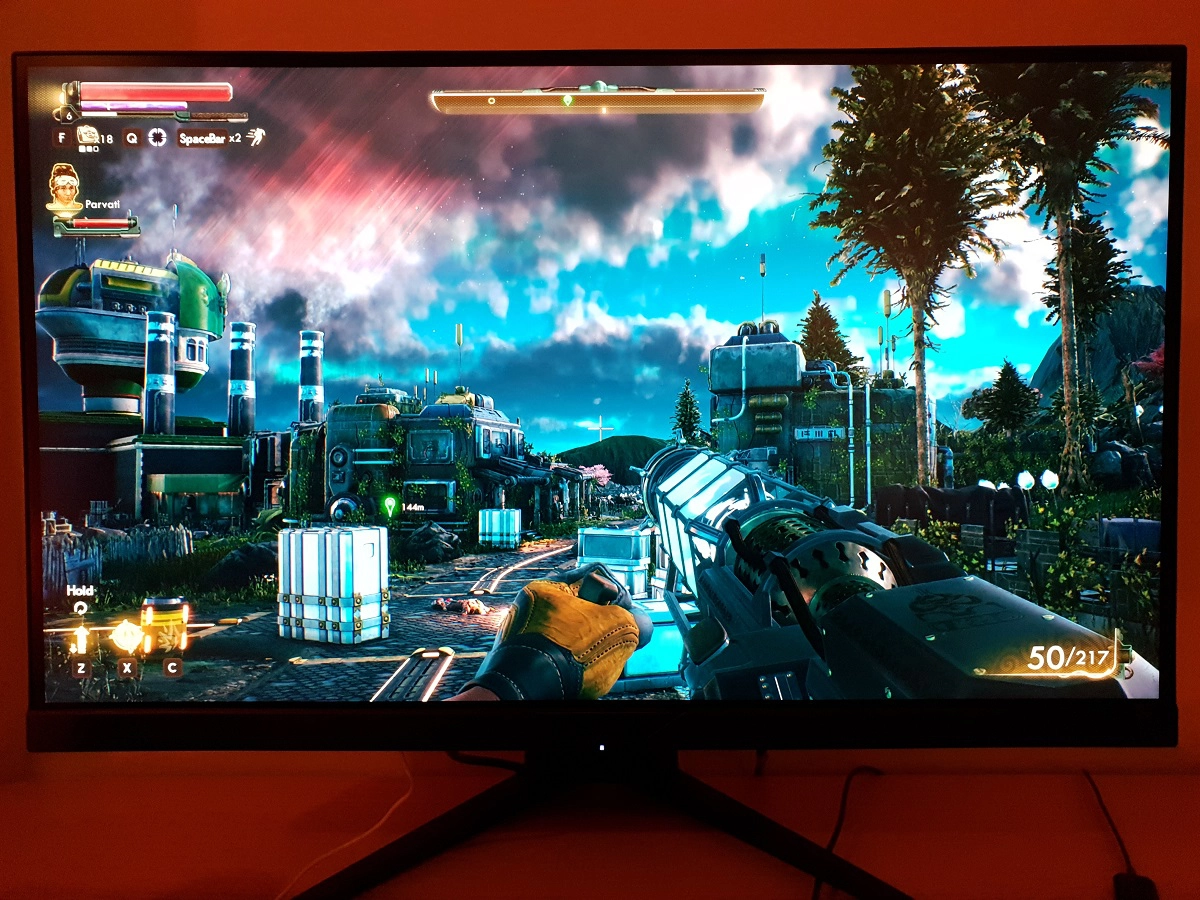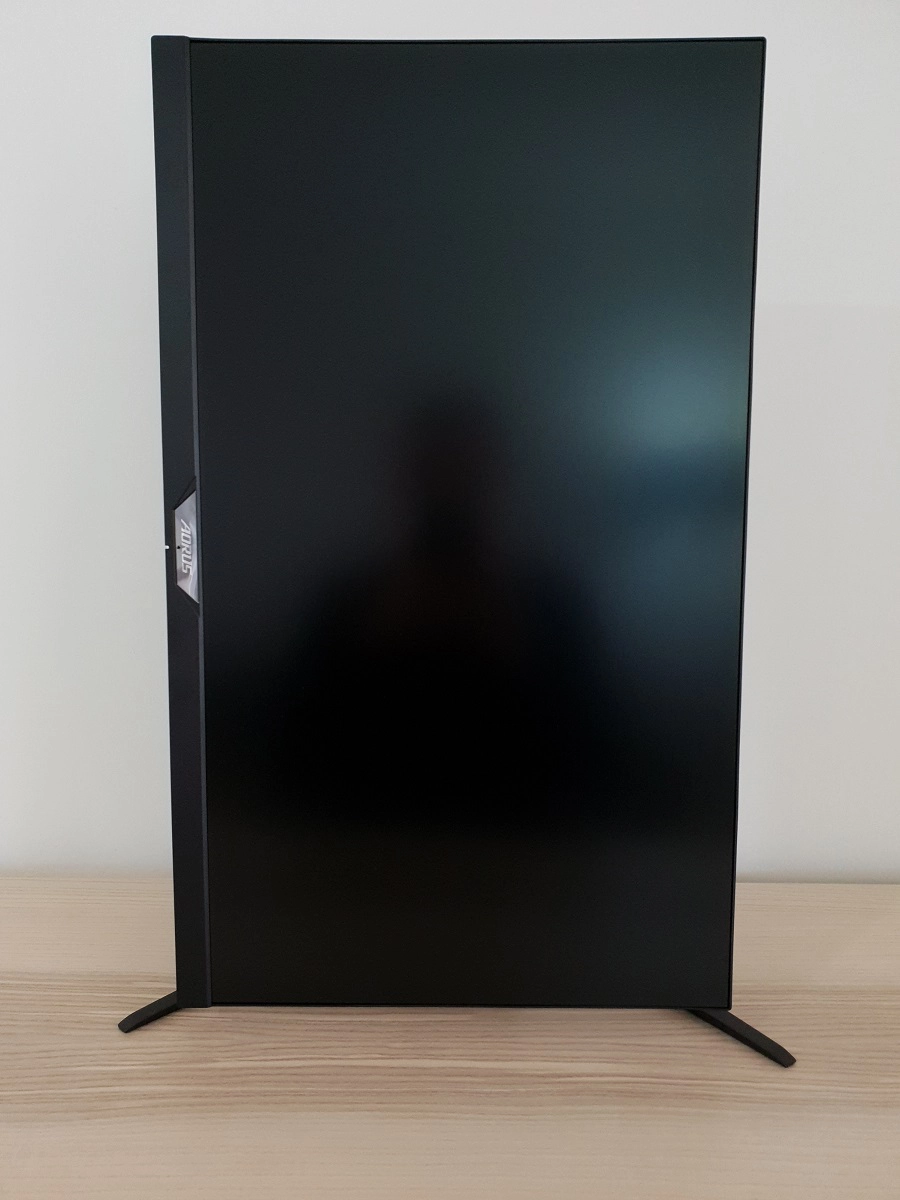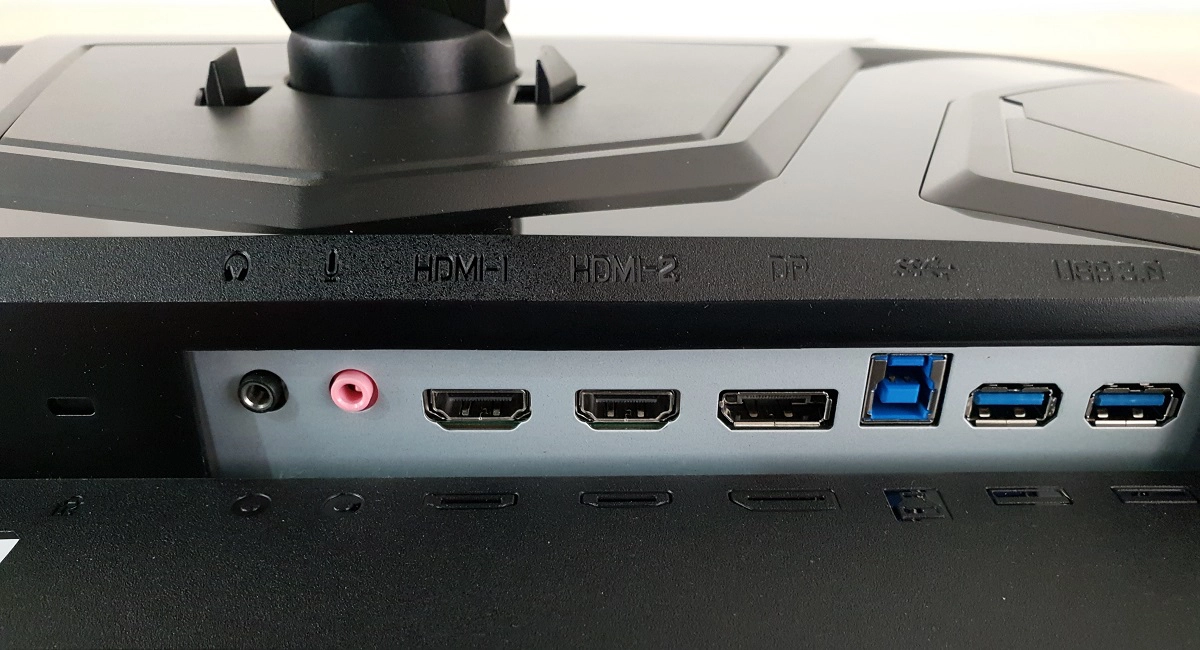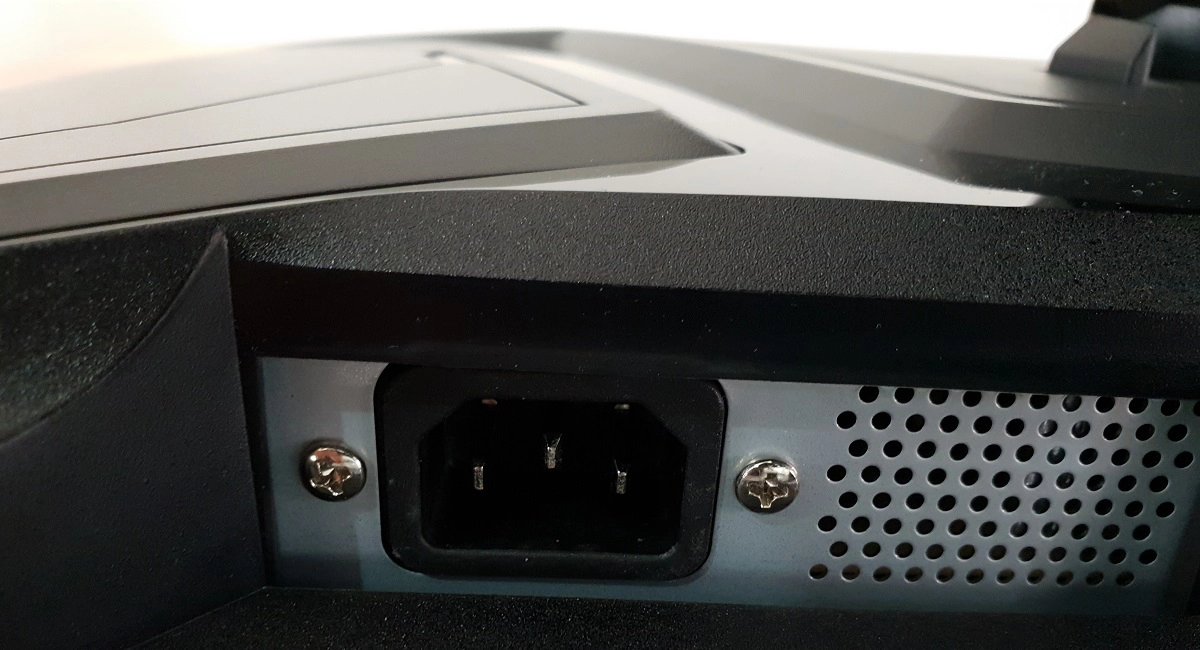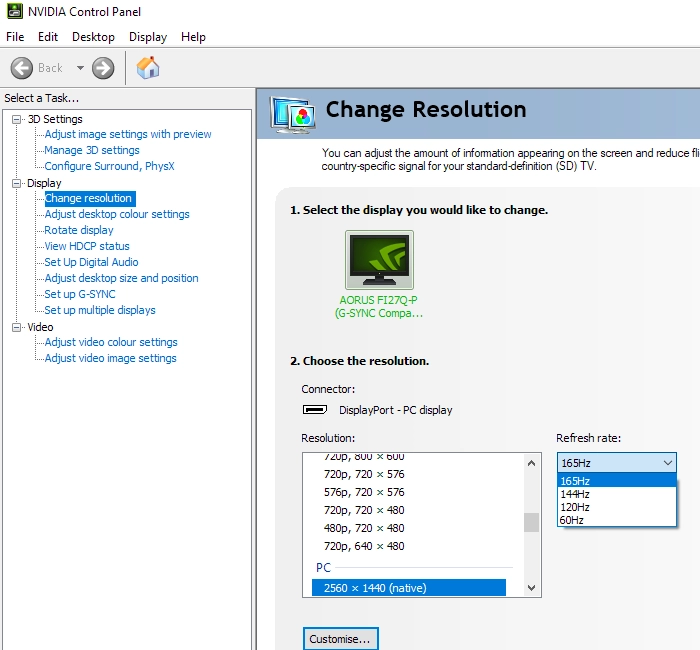Author: Adam Simmons
Date published: April 24th 2020
Table of Contents
Introduction
As a veteran of the PC gaming market more broadly, it was only a matter of time before Gigabyte entered the gaming monitor scene. The first model released, through their AORUS sub-brand, was the AD27QD. A pretty solid initial showing, really, offering strong performance in many key areas. The Gigabyte AORUS FI27Q-P (and slightly cut-down FI27Q) follows up on this, slightly increasing the maximum refresh rate from 144Hz to 165Hz. The ‘P’ variant, which we’re reviewing here, also supports HBR3 (High Bit Rate 3) to enhance its bandwidth capabilities. Allowing the monitor to handle a 10-bit colour signal at high refresh rates and under HDR, rather than relying on GPU-level dithering to fill in some gaps. That just covers the ‘on paper’ changes, there’s potential for further tweaking that the specifications won’t tell you about. We put this monitor through its paces to see how it performs in our usual suite of ‘real world’ tests.
Specifications
The monitor adopts a 27” AAS (Azimuthal Anchoring Switch) panel from Innolux technology. More specifically, an IPS-type (In-Plane Switching) iteration of AAS, which confusingly enough also comes in VA (Vertical Alignment) flavour. This supports a 2560 x 1440 resolution, 165Hz refresh rate and 10-bit colour (8-bit + FRC dithering). A 1ms MPRT (Moving Picture Response Time) is specified, with the monitor using its strobe backlight function. Some of the key ‘talking points’ for this monitor have been highlighted in blue below.
The monitor has a ‘gameresque’ appearance from the front, with sharp lines and a fairly aggressive appearance. Matte black is used extensively without flashy RGB LEDs at the front or other flashes of colour. The overall styling is not too dissimilar to some recent Acer Predator models. The Y-shaped stand base has a matte black powder-coated metal finish, for a premium look and feel. The top and side bezels are quite slim, with a dual-stage (‘3-side borderless’) design. This includes a slender panel border that’s flush with the rest of the screen, plus a slim hard plastic outer component. The bottom bezel is thicker, matte black plastic with a central shiny silver-coloured AORUS logo, with a glossy black (mirror-finish) surround. The total thickness of the bezels is ~7.5mm (0.30 inches) at the top and sides and ~25mm (1.00 inch) at the bottom including a sliver of panel border. The main feature from the front is the 27” screen, with a light matte anti-glare finish as we explore later. The OSD (On Screen Display) is controlled by a joystick at the bottom of the monitor, facing downwards beneath the central logo. Beneath this logo (facing forwards) is a small power LED that glows cool white when the monitor is on and amber when it enters a low power state. If preferred, you can disable the power LED during normal monitor operation in the OSD. The menu system and RGB LED lighting feature (controllable using ‘RGB Fusion 2.0’ software) is explored in the video below. We also look at the OSD Sidekick software as an alternative method of OSD control. The screen is fairly slender at the side, ~16mm (0.63 inches) at thinnest point but lumping out further centrally at the stand attachment point. The stand offers full ergonomic flexibility; tilt (5° forwards, 21° backwards), swivel (20° left and 20° right), height (130mm or 5.12 inches) and pivot adjustment (90° clockwise rotation into portrait). At lowest height the bottom of the monitor sits ~70mm (2.76 inches) above the desk, with the top of the screen ~440mm (17.32 inches) above the desk surface. There’s also a carrying handle at the top of the stand neck poking up ~46mm (1.81 inches) above the top of the screen with the stand set to its lowest height. The total depth of the monitor including stand is ~250mm (9.84 inches), with the screen lined up well with the front edges of the stand base. The stand is therefore less of a desk depth hog than many models, particularly those with distinct ‘gaming monitor’ designs. It takes up a bit more desk space than some 27” models, however. At the rear the monitor combines matte black and dark grey plastics with a few glossy plastic areas. These glossy elements include wing-like areas either side of the stand neck and a feature towards the top of the stand neck. Within these glossy areas there are embedded RGB LEDs. These include some linear patterns at the sides and a central AORUS flacon logo. Additional RGB LEDs are found in some glossy regions at the side of the stand neck. The RGB LED lighting feature is explored in the OSD video featured earlier in the review. The top of the stand neck includes a carrying handle, whilst the bottom includes a hexagonal cable-tidy loop. The included stand has a quick-release mechanism, with the screen easily removable by pinching two ‘buttons’ either side of the attachment point inwards. This will reveal 100 x 100mm VESA holes for alternative mounting. The ports face downwards and include; AC power input (internal power converter), 3.5mm headphone jack, 3.5mm microphone jack, 2 HDMI 2.0 ports, DP 1.4 (HBR3) and 2 USB 3.2 downstream ports (plus upstream). A K-Slot is located between the power input and headphone jack. The full capability of the monitor including the 165Hz refresh rate, Adaptive-Sync (includes AMD FreeSync and Nvidia’s ‘G-SYNC Compatible Mode’) and HDR requires DP 1.4. The monitor leverages HBR3 via DP to allow these features to be used alongside 10-bit colour processing, where applicable. HDMI 2.0 is limited to 144Hz max and supports AMD FreeSync but not Nvidia’s ‘G-SYNC Compatible Mode’. Standard accessories include a DP cable, HDMI cable, USB cable and power cable. The images below show the refresh rates available for the Full HD resolution (top two images) and native WQHD resolution (bottom image), when using DisplayPort. If connected via HDMI, a ‘4k x 2k, 3840 x 2160’ resolution is also listed, downsampling the ‘4K’ UHD resolution. This is shown in the image below. Such functionality is useful for devices such as games consoles that might not natively support the 2560 x 1440 (WQHD) resolution, so they’re able to use a ‘4K’ signal. PC users can also run this upscaled resolution if they wish, but it’s limited to 60Hz so using a similar feature in the graphics driver might make more sense. The image below is a macro photograph taken on Notepad with ClearType disabled. The letters ‘PCM’ are typed out to help highlight any potential text rendering issues related to unusual subpixel structure, whilst the white space more clearly shows the actual subpixel layout alongside a rough indication of screen surface. This model uses a light matte anti-glare screen surface with relatively smooth surface texture. This offers quite good glare handling, avoiding the sort of distinct reflections you’d see on a glossy screen. It also preserves clarity and vibrancy better than ‘stronger’ matte screen surfaces. There’s a light misty graininess when observing lighter content that most users will be fine with and many won’t even notice at all. The screen surface texture is just slightly less smooth than some competing models (using LG Nano IPS panels, for example) but significantly smoother than competing 27” WQHD VA models. As illustrated above the standard RGB (Red, Green and Blue) stripe subpixel layout is used. This is the default expected by modern operating systems such as Microsoft Windows and Apple MacOS. You needn’t worry about text fringing from non-standard subpixel layouts as a Mac user and don’t need to run ClearType as a Windows user. You may still wish to run through the ClearType wizard and adjust according to preferences, however. The subpixel layout and arrangement is normal and we had no subpixel-related concerns related to sharpness or text clarity on this model. The monitor includes a range of ‘Picture Mode’ image presets; ‘Standard’, ‘AORUS’, ‘FPS’, ‘RTS/RPG’, ‘Movie’, ‘Reader’, ‘sRGB’, ‘Custom 1’, ‘Custom 2’ and ‘Custom 3’. As is often the case most of these presets simply change various OSD settings that could simply be adjusted manually and some grey out various settings. We take a brief look at these in the OSD video, but for this section we’ll mainly focus on manual adjustments. The 3 numbered ‘Custom’ picture modes are useful as they give you full flexibility in the OSD and allow you to easily store and recall 3 different sets of settings. The following provides key readings (gamma and white point) taken using a Datacolor SpyderX Elite colorimeter, alongside some general observations. Our test system uses Windows 10 with an Nvidia GTX 1080 Ti, connected using the supplied DisplayPort cable. Additional testing was performed using an AMD Radeon RX 580 and also using HDMI 2.0, although observations in this table didn’t vary significantly between the GPUs or inputs. No additional monitor drivers or ICC profiles were specifically loaded. The screen was left to run for over 2 hours before readings were taken or observations made. Aside from our ‘Test Settings’ where various adjustments are made, assume factory defaults were used. The refresh rate was set to 165Hz in Windows, but that didn’t significantly affect the values or observations in this table. When viewing the figures in this table, note that for most PC users ‘6500K’ for white point and ‘2.2’ for gamma are good targets to aim for. Individual targets depend on individual uses, tastes and the lighting environment, however. We upgraded the firmware to the latest available revision (‘F03’) using the OSD Sidekick utility available on Gigabyte’s website. This was a simple process that the software guides you through – it requires that the USB upstream cable is connected to the monitor.
As an Amazon Associate I earn from qualifying purchases made using the below link. Where possible, you’ll be redirected to your nearest store. Further information on supporting our work.

Features and aesthetics
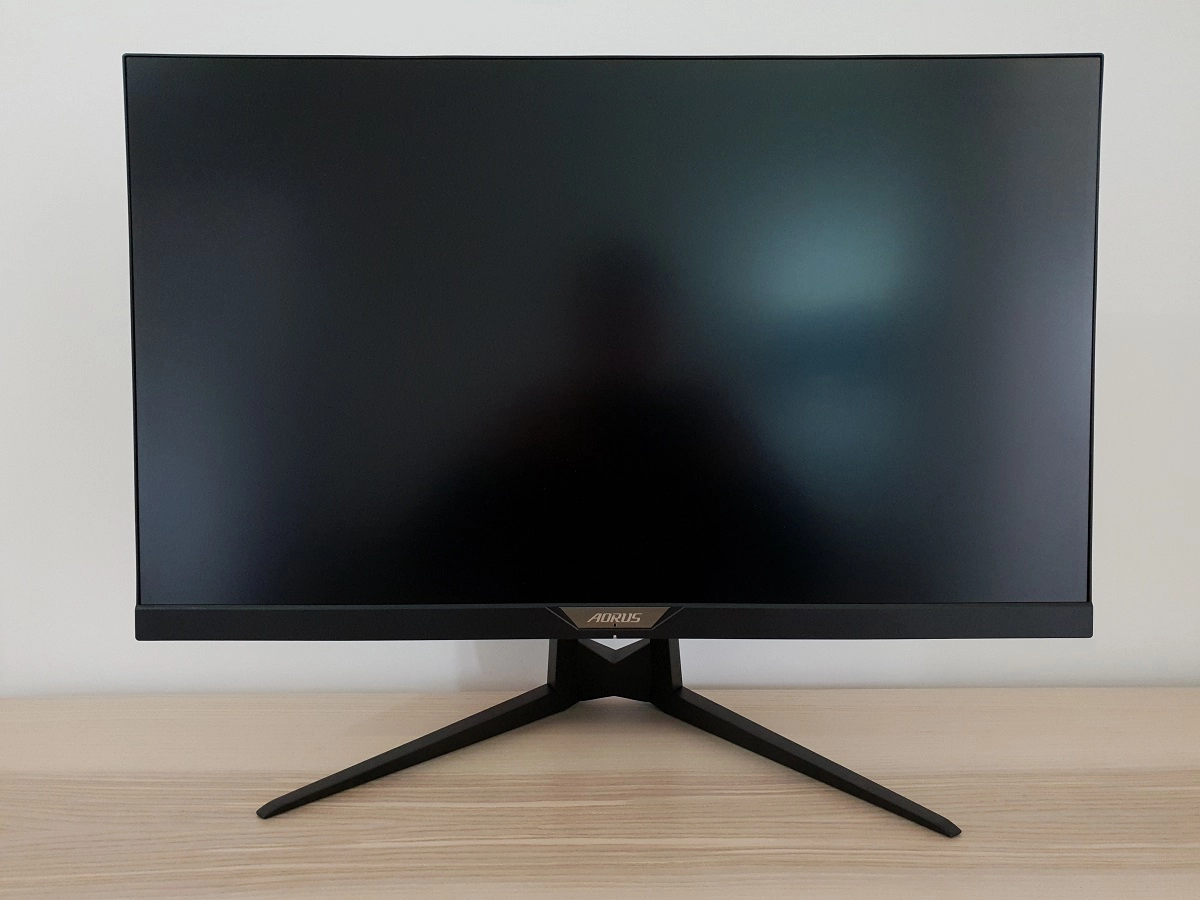
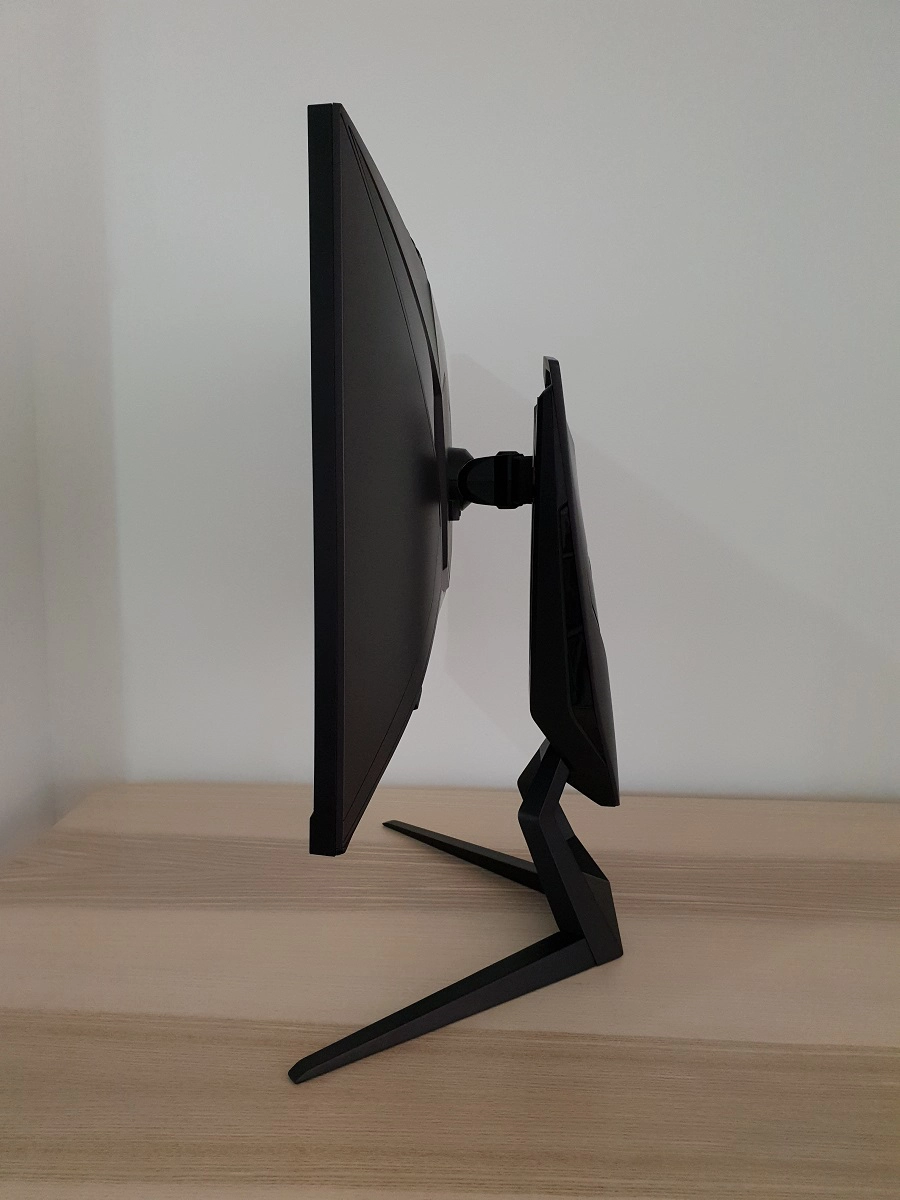
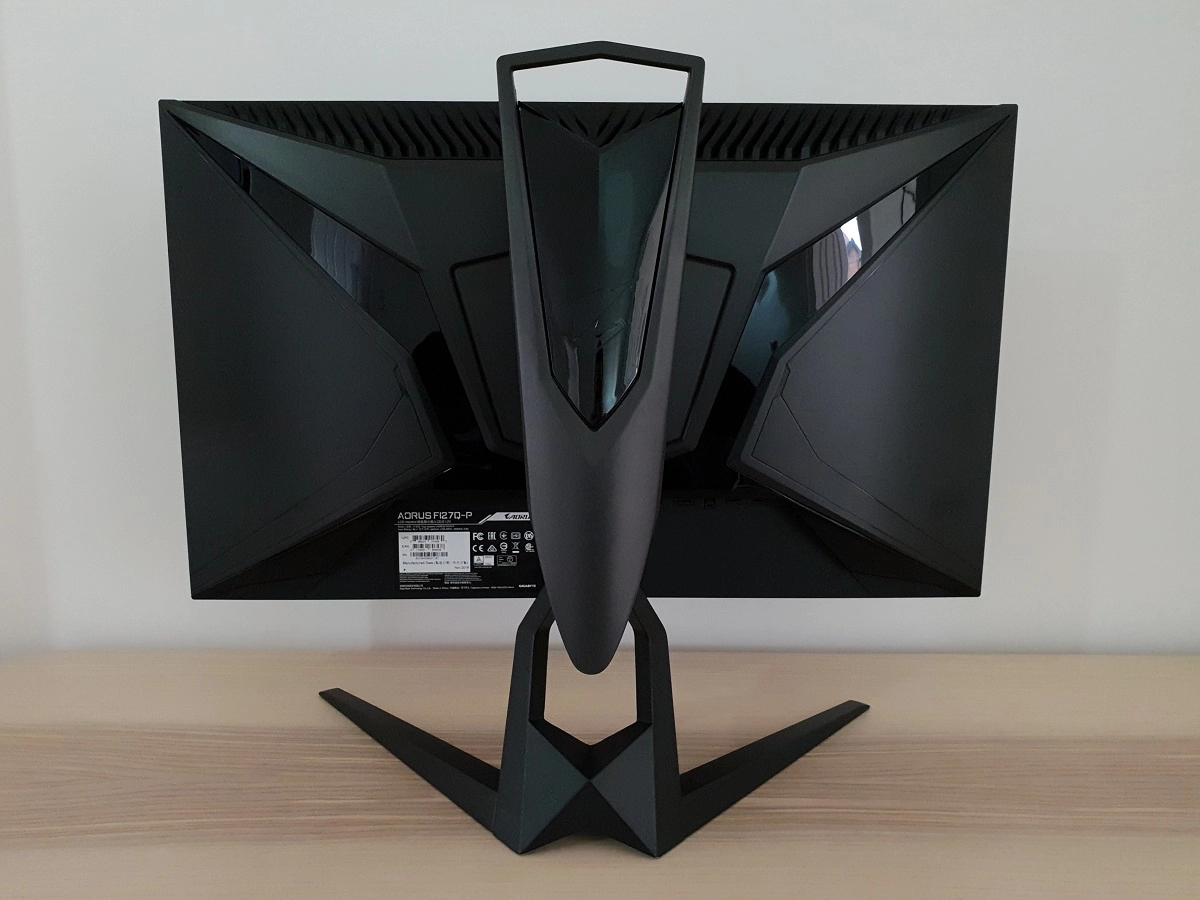
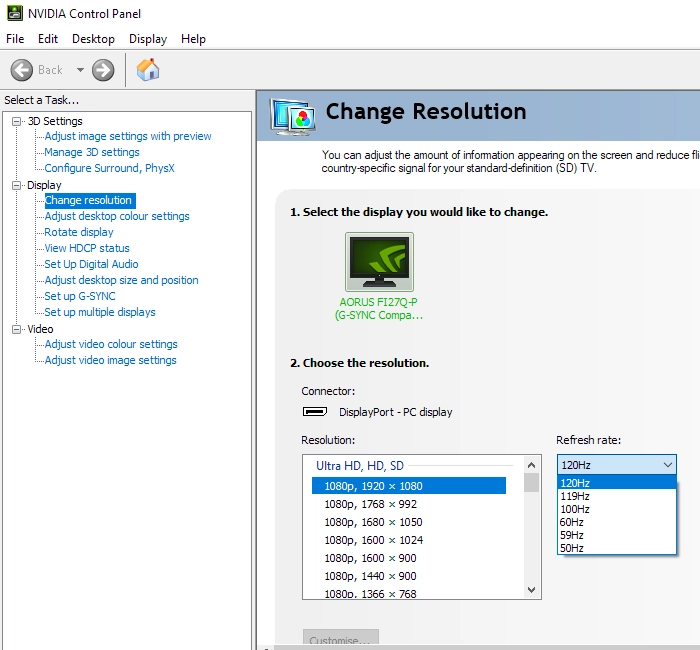
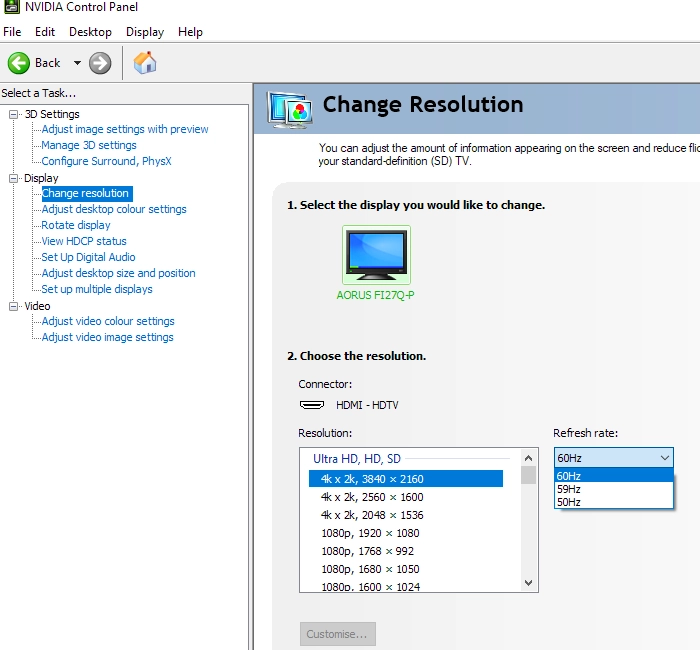
Calibration
Subpixel layout and screen surface
![]()
Testing the presets
Monitor Settings Gamma (central average) White point (kelvins) Notes Gamma = OFF (Factory Defaults) 2.2 7214K A vibrant look to the image with a noticeable cool tint. Some shade crushing for more saturated shades due to ‘Color Vibrance’ being set to ‘11’ – easily remedied. Gamma 1 1.8 7044K As above but a significant lack of depth, quite a washed out appearance really. Gamma 2 2.0 7096K As above, slightly more depth due to increased gamma. Gamma 3 2.2 7161K Very similar to factory defaults. Gamma 4 2.4 7223K As above but extra depth and saturation due to elevated gamma. Gamma 5 2.6 7285K As above, further increase in gamma. Quite a bold and cinematic look to the image, significant loss of distinction between closely matching dark shades. Low Blue Light = 10 2.2 5437K An effective Low Blue Light (LBL) setting. The blue colour channel is weakened significantly, providing a warmer look to the image with reduced blue light output. The green channel remains relatively strong, giving a noticeable green tint to the image. Your eyes adjust to this over time, to an extent, but never fully compensate. Color Temperature = Warm 2.2 4941K An alternative LBL setting. Similar effectiveness with a warmer and less green tint to the image. The green channel is reduced as well. Color Temperature = User Define 2.2 6546K Similar to factory defaults but better balanced without obvious cool tint. The green channel is slightly too weak relative to green and blue, giving a slight purple tint in places. Picture Mode = Reader 2.0 5989K Significantly reduced depth, saturation, contrast and brightness. A warm-green tint to the image. A weak LBL setting with further adjustments made in the OSD by default. Picture Mode = sRGB 2.2 6307K This is an sRGB emulation setting. Saturation is reduced significantly, with the colour gamut curtailed to follow sRGB more closely. The image has a slightly purple cast due to the green channel being somewhat weak relative to red and blue. Adjustments are restricted in this mode, including locked brightness and colour channels. Test Settings (see below) 2.2 6516K A vibrant, varied and well-balanced image with comfortable brightness.
Straight from the box the monitor provided a vibrant image with a noticeable cool tint. There was some shade crushing for more saturated shades due to the ‘Color Vibrance’ being set to ‘11’ rather than the neutral and optimal setting of ’10’. This was easily corrected. Gamma tracked closely to the desirable ‘2.2’ curve. The graph below shows gamma tracking under our ‘Test Settings’, which is similar to the factory defaults. Given the intended uses for monitor, inter-unit variation and strong performance with just OSD tweaking we will not be using any ICC profiles for this review. We wouldn’t recommend using them unless created for your specific unit with your own calibration device, either. We appreciate some users still like to use profiles and some aspects such as gamut mapping for colour-aware applications can be useful. You can download our ICC profile for this model if you wish, which was created using our ‘Test Settings’ as a base. But note again it is not used in this review. The monitor also has a few different Low Blue Light (LBL) settings. Reducing blue light exposure is particularly important in the hours leading up to sleep as blue light is stimulating to the body and impacts sleep hormone levels. It keeps the body alert and makes it more difficult to relax, which isn’t conducive to relaxing. The main ‘Low Blue Light’ setting can be set to varying levels of effectiveness between ‘1’ (weakest effect) and ‘10’ (strongest effect). Using the strongest setting, there was a significant blue light reduction with a warmer and somewhat green tint to the image. The green tint was due to the green channel remaining relatively strong. We preferred the balance to the image using the alternative LBL setting, achieved by setting ‘Color Temperature’ to ‘Warm’. There was no green cast, which as we explore later has a minor contrast impact. We used this setting for our own viewing comfort in the evening, but not for specific testing outside of that involving the setting itself. It’s also worth noting that the panel used in this monitor has a shifted blue light energy peak from the usual 450nm to 455nm, regardless of whether LBL settings are being used or not. This may not sound like much, but it’s an important viewing comfort consideration for some users. It’s enough to give a potentially ‘gentler’ or ‘less harsh’ look to the image compared to models using the more common and energetic 450nm blue peak. This includes models using current LG Nano IPS panels, such as the ViewSonic XG270QG. Our ‘Test Settings’ involved switching to one of the ‘Custom’ presets and making a few tweaks including reducing brightness. The ‘Standard’ setting could also have been used, but ‘Color Vibrance’ is set to ‘11’ rather than the neutral (and optimal) value of ‘10’ under that preset. This can be adjusted, but it’s already set correctly with the ‘Custom’ presets. Note that individual units and preferences vary, so these settings are simply a suggestion and shouldn’t be expected to work optimally in all cases. Assume any setting not mentioned, including ‘Contrast’ and ‘Gamma’, was left at default. We’ve also included the refresh rate used in Windows and our preferred ‘Overdrive’ setting, just for reference. Note that these settings apply to SDR, which is used for the bulk of the review. HDR locks off most settings and configures things automatically. Brightness= 30 (according to preferences and lighting) Color Temp. = User Define R= 98 Green= 100 Blue= 98 Overdrive= Speed FreeSync= On Refresh rate (Windows setting)= 165Hz An X-Rite i1Display Pro was used to measure the luminance of white and black using various monitor settings, including those discussed earlier. From these values static contrast ratios were recorded. As shown in the table below. Blue highlights indicate the results under our ‘Test Settings’ and with HDR active. Black highlights indicate the highest white luminance, lowest black luminance and highest contrast ratio recorded (HDR and ‘Aim Stabilizer’ deactivated). Assume any setting not mentioned was left at default, aside from the exceptions noted here or in the calibration section.
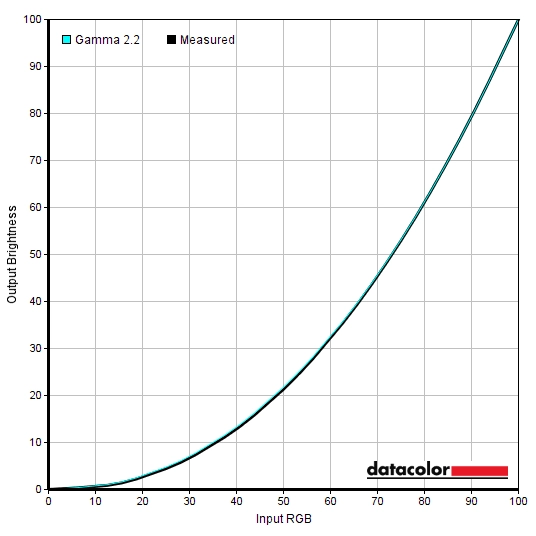
Gamma 'Test Settings'
Test Settings
Picture Mode = Custom 1 (other ‘Custom’ presets can be used if preferred)
Contrast and brightness
Contrast ratios
Monitor Settings White luminance (cd/m²) Black luminance (cd/m²) Contrast ratio (x:1) 100% brightness 437 0.39 1121 80% brightness 366 0.32 1144 60% brightness 289 0.26 1112 40% brightness 211 0.19 1111 20% brightness 127 0.11 1155 0% brightness 36 0.03 1200 85% brightness (Factory Defaults) 385 0.34 1132 HDR* 434 0.41 1059 Gamma = 1 388 0.34 1141 Gamma = 2 387 0.34 1138 Gamma = 3 385 0.34 1132 Gamma = 4 384 0.34 1129 Gamma = 5 383 0.34 1126 Low Blue Light = 10 375 0.34 1103 Color Temperature = Warm 362 0.34 1065 Color Temperature = User Define 400 0.34 1176 Color Temperature = User Define (100% brightness) 456 0.39 1169 Picture Mode = Reader 233 0.26 896 Picture Mode = sRGB 162 0.15 1080 Aim Stabilizer @120Hz 131 0.12 1092 Aim Stabilizer @144Hz 151 0.13 1162 Aim Stabilizer @165Hz 158 0.14 1129 Test Settings 175 0.15 1167
*HDR measurements were made using this YouTube HDR brightness test video, running full screen at ‘1440p HDR’ on Google Chrome. The maximum reading from the smallest patch size (measurement area) that comfortably covered the entire sensor area and colorimeter housing was used for the white luminance measurement, which was ‘4% of all pixels’ in this case. The black luminance was taken at the same point of the video with the colorimeter offset to the side of the white test patch, equidistant between the test patch and edge of the monitor bezel.
The average static contrast with only brightness adjusted was 1139:1, quite respectable for the panel type. This was marginally higher under our ‘Test Settings’, at 1167:1. A contrast ratio beyond the specified 1000:1 was maintained under all settings tested, aside from the ‘Reader’ setting which lowered the ‘Contrast’ setting by default. The highest white luminance recorded was 437 cd/m², whilst the minimum white luminance recorded was 36 cd/m². This provides a luminance adjustment range of 401 cd/m², with a fairly low minimum and quite bright maximum. Activating HDR on the monitor yielded a peak brightness of 434 cd/m², slightly below the peak recorded under SDR but likely due to the backlight compensating slightly for the dark background surrounding the white square used in the test. There was no contrast advantage under HDR as the monitor does not support local dimming.
The monitor offers no local dimming and therefore there was no contrast benefit under HDR. The peak luminance recorded was 495 cd/m², using the ‘Game HDRi’ and ‘Cinema HDRi’ modes in a very bright room. And by this, we mean lots of sunlight streaming into the room on a bright day. These settings respond to ambient lighting using the ‘B.I.+’ technology discussed shortly, so the backlight brightness is raised as much as possible to try to compete with that bright ambient light. Dimmer luminance values were recorded in a moderately bright room (fairly bright day but no sun streaming directly in) and significantly dimmer in a dark room. Even in a moderately bright room the recorded luminance level was distinctly ‘non-HDR’ in terms of brightness levels and a fair bit below the peak luminance recorded under SDR even. The ‘Display HDR’ setting provided a rather bright 466 cd/m², although this was held back slightly due to the fact the test uses a white square surrounded by black rather than a white screen fill. This is more representative of actual viewing conditions, though, as you wouldn’t typically have the entire screen displaying white.
The monitor also includes a ‘Dynamic Contrast’ setting, allowing the backlight to adjust in a similar fashion under SDR as well. You can set this between ‘1’ and ‘5’ with a higher setting simply increasing gamma – even ‘1’ increases this significantly compared to the setting disabled under our ‘Test Settings’. You can manually adjust the brightness which allows you to cap the maximum luminance, so the setting only dims from there for darker content. This is a good flexibility to have and makes it a better implementation than many models offer, but we still prefer manually setting the brightness level.
PWM (Pulse Width Modulation)
The FI27Q-P does not use PWM (Pulse Width Modulation) under any brightness setting and instead uses DC (Direct Current) to regulate backlight brightness. The backlight is therefore considered ‘flicker-free’, which will come as welcome news to those sensitive to flickering or worried about the side-effects of PWM usage. The exception to this is with ‘Aim Stabilizer’ function active, as this is a strobe backlight function which causes the backlight to flicker at a frequency matching the refresh rate of the display.
Luminance uniformity
Whilst observing a black background in a dark room, using our ‘Test Settings’, we noticed a small amount of backlight bleed and a little clouding. Although our sample was relatively impressive in this respect, it’s important to remember that individual units vary when it comes to backlight bleed and clouding. The image below shows the results on our unit, with the photo taken a sufficient distance away to eliminate ‘IPS glow’. This is a sheen that’s visible most clearly towards the bottom corners of the screen, from a normal viewing position. It appears a cool-grey towards the left and warm grey (or slightly golden) towards the bottom right. From sharper viewing angles it appears to ‘bloom out’ more noticeably, particularly where it takes on a cool tint. This behaviour is shown in the viewing angles video deeper into the review. The luminance uniformity was strong overall. The maximum luminance was recorded at ‘quadrant 5’ in the centre of the screen (168.1 cd/m²). The greatest deviation from this occurred at ‘quadrant 3’ towards the top right of the screen (150.9 cd/m², which is 10% dimmer). The average deviation between each quadrant and the brightest recorded point was 6%, which is quite respectable. Remember that individual units vary when it comes to uniformity and you can expect further deviation beyond the points measured. The contour map below shows these deviations graphically, with darker greys representing lower luminance (greater deviation from brightest point) than lighter greys. The percentage deviation between each quadrant and the brightest point recorded is also given. The SpyderX Elite was also used to analyse variation in the colour temperature (white point) for the same 9 quadrants, as shown below. The deviation between each quadrant and the quadrant closest to the 6500K (D65) daylight white point target was analysed and a DeltaE value assigned. A DeltaE <3 represents non-significant deviation that most users shouldn’t readily notice by eye. Results here were good, with no significant deviations recorded. The greatest deviation occurred towards the top right (DeltaE 2.9). It’s again important to note that individual units vary when it comes this and other aspects of uniformity. Furthermore, you can expect deviation beyond the measured points. The monitor provided a respectable contrast experience on Battlefield V. Brighter elements contrasted well with darker surroundings, with the screen surface keeping these brighter elements free from obvious graininess. Darker content such as shadowy areas and dimly lit building interiors had better atmosphere than some competing models, including those using LG Nano IPS panels with their somewhat weaker static contrast. There was a moderate but by no means extreme amount of ‘IPS glow’. This was most noticeable near the bottom corners of the screen from a normal viewing position. The brightening up of darker shades here with a ‘bloom’ in affected regions which negatively impacted the overall atmosphere of such scenes. This tended to be most eye-catching towards the bottom left due to the cool tint of the ‘IPS glow’ here. The relatively good dark uniformity of our unit (low ‘backlight bleed’ etc.) helped subdue this somewhat – more significant backlight bleed would bring out ‘IPS glow’ or more noticeably. In fact the ‘VA glow’ we’ve seen on competing models was arguably more noticeable than the ‘IPS glow’ observed here. The central area of the screen beyond the reaches of this ‘glow’ showed appropriate detail, with the decent static contrast and consistent gamma handling maintaining good but not excessive detail levels. The sort of gamma and hence detail level inconsistencies you’d see on VA and moreover TN models as you observe different parts of the screen were thankfully absent. We made similar observations on Shadow of the Tomb Raider. This title demands a strong contrast performance to look its best, with plenty of dimly lit caves, tombs, passageways and other interior spaces. The monitor provided a fairly atmospheric look to such areas, a touch above some other models we’ve tested recently. ‘IPS glow’ was again observed, most noticeably towards the bottom corners, but this was far from excessive and again aided on our unit by respectable dark uniformity. Brighter elements such as fires and the sun in the sky did not appear overly grainy thanks to the reasonably smooth screen surface. Just a light ‘misty’ graininess that most users will find just fine or not really notice in the first place. The consistent gamma handling again avoided the sort of vertical ‘detail gradient’ you’d see on TN models when observing darker content. And avoided things appearing too masked centrally and in some cases unintended details being brought out peripherally, as you’d see on VA models. We also observed the film Star Wars: The Last Jedi. There are plenty of scenes on this title where strong contrast is important. And in that respect things actually looked reasonably cinematic, especially impressive for the panel type. Brighter elements such as explosions and pulses of energy contrasted well with their much darker surroundings. The depth of the dark shades was quite decent, although not what we’d describe as ‘deep and inky’. Particularly if the room you’re sitting in is fairly dim. ‘IPS glow’ also featured – but we still found the title quite watchable and sufficiently absorbing. The consistent gamma handling could again be appreciated, but this is even more important on heavily compressed streamed content. Such content has ‘compression artifacts’ which can be far less blended than they should be if perceived gamma is lower than it should be. That gives a ‘blocky’ or ‘banded’ appearance in places. The sort of thing you’d observe towards the bottom of a TN model or potentially the edges of a VA model, even if the screen is calibrated appropriately. Such details were suitably well-blended on this model and didn’t stand out inappropriately. Just as a general observation, we also spent quite a bit of time watching such content on Netflix and other streaming services and found the overall perceived contrast about as good as we’ve seen from an IPS-type model without local dimming. The Lagom tests for contrast allow specific weaknesses in contrast performance to be identified. The following observations were made. The Gigabyte AORUS FI27Q-P’s colour gamut (red triangle) was compared with the sRGB (green triangle) and DCI-P3 (blue triangle) reference colour spaces using our ‘Test Settings’, as shown below. The monitor fully covers the sRGB colour space, with significant extension beyond. According to our measurements, 95% DCI-P3 coverage was achieved – matching the manufacturer specifications. Although not shown in the graphic, 89% Adobe RGB coverage was recorded. This sort of colour gamut is appropriate for HDR content, where DCI-P3 is the target colour space and good coverage of this is desirable. It also gives the monitor the potential to output all shades in the sRGB colour space (for normal SDR content) with a fair dose of extra vibrancy and saturation. The gamut below shows results using our ‘Test Settings’ with this driver tweak applied. The colour gamut now fully covers sRGB (100%), although there’s now a bit of extension beyond. Much less than using the native gamut of the monitor without this setting applied, however. This is a useful setting if you’re an AMD user and wish to gain fairly close tracking of the sRGB gamut without profiling, including in applications that aren’t colour-managed. On Battlefield V the monitor provided a vibrant and varied spectrum of shades. The generous colour gamut injected extra vibrancy into content like this and indeed other game content. Which, under SDR, is designed with the sRGB colour space in mind. The extension beyond this meant things were presented with extra saturation. This wasn’t like a digital saturation boost (e.g. the ‘Color Vibrance’ feature in the OSD or Nvidia’s ‘Digital Vibrance Control’) which pushes shades closer to the edge of the colour gamut without expanding the gamut, greatly reducing shade variety and giving a cartoonish appearance. This was an even injection of saturation and vibrancy, with shades maintaining appropriate variety. A rich palette of earthy browns, lush greens and more muted shades was displayed. There was a touch too much red to some of the reddish browns and some of the vegetation appeared with a somewhat strong yellowish green hue. But the overall look is one many will find quite inviting – vibrant elements such as brightly painted objects and roaring fired appeared suitably eye-catching as well. On Shadow of the Tomb Raider we made similar observations. Vibrant elements such as golden artifacts, flames and some of Lara Croft’s elaborate attire were displayed with excellent vivacity and variety. Some of the blues and purples were particularly striking, here. The environments appeared varied and natural on the whole, although saturation levels were stronger than intended which made some of the more muted and dusty shades appear a bit lively in places. The consistency of shades was strong on both titles, with this vibrant appearance maintained throughout the screen. This contrasts with VA and moreover TN models where perceived gamma and saturation levels shifts depending on which area of the screen you’re observing. We also observed various episodes of Futurama. This title features large areas of individual shades and was good at highlighting the IPS-type panel’s colour consistency strengths. Some shades appeared just a touch less saturated towards the very edges of the screen, such as certain pastel purple shades. But consistency was significantly improved compared to VA or TN panels and it was clear this was an IPS-type panel. There were plenty of vibrant shades and an excellent variety of closely matching pastel shades. Again there were licks of extra saturation, but a suitable variety and a vivid appearance. Lagom’s tests for viewing angle were used to further explore colour consistency and viewing angle performance. The following observations were made from a normal viewing position, eyes around 70cm from the screen. Sitting closer to the screen exaggerates the slight shifts explored here. On some monitors, particularly but not exclusively those with high refresh rates, interlace patterns can be seen during certain transitions. We refer to these as ‘interlace pattern artifacts’ but some users refer to them as ‘inversion artifacts’ and others as ‘scan lines’. They may appear as an interference pattern, mesh or interlaced lines which break up a given shade into a darker and lighter version of what is intended. They often catch the eye due to their dynamic nature, on models where they manifest themselves in this way. Alternatively, static interlace patterns may be seen with some shades appearing as faint horizontal or vertical bands of a slightly lighter and slightly darker version of the intended shade. We did not observe static interlace patterns, but we did observe some dynamic interlace pattern artifacts under certain conditions. When viewing certain shades at specific movement speeds from a relatively close viewing distance, we could see faint vertical interlaced lines. In other words; we observed these under very artificial conditions which aren’t representative of how most users will view the monitor. So it’s not something we’d worry about during normal use or that most users will even come across at all. We observed these a lot more clearly with the ‘Aim Stabilizer’ function active, however. A small utility called SMTT 2.0 was used alongside a sensitive camera to analyse the latency of the FI27Q-P, with over 30 repeat readings taken to help maximise accuracy. Using this method, we calculated 3.80ms (~ 2/3rds of a frame at 165Hz) of input lag. The input lag measured here is influenced by both the element you ‘see’ (pixel responsiveness) and the element you ‘feel’ (signal delay). It indicates a very low signal, which even sensitive users shouldn’t find bothersome. Note that we don’t have the means to accurately measure input lag with Adaptive-Sync active in a variable refresh rate environment or with HDR active in an HDR environment. Our article on responsiveness explores some of the key concepts surrounding monitor responsiveness. Chief amongst these is the concept of perceived blur, which is contributed to by both the pixel responsiveness of the monitor and the movement of your eyes as you track motion on the screen. This second factor is dominant on modern monitors, although slower than optimal pixel responses are still an important contributor. We also look at ‘pursuit photography’, a technique which uses a moving rather than static camera to capture motion in a way that reflects both key elements of perceived blur. The images below are pursuit photographs taken using the UFO Motion Test for ghosting, with the UFO moving across the screen from left to right at a frame rate matching the refresh rate of the display. The test is set to run at its default speed of 960 pixels per second, which is a good practical speed for such photographs. The monitor was tested at 60Hz (directly below), 120Hz, 144Hz and 165Hz with all three ‘Overdrive’ settings; ‘Picture Quality’, ‘Balance’ and ‘Speed’. All rows of the UFO Motion Test were used, showing a range of pixel transitions between various shade grey levels. The final columns show some reference screens for comparison, where possible. The Gigabyte AORUS AD27QD, which is the predecessor to this model. And the ViewSonic XG270QG, which is a competitor to this model featuring an LG Nano IPS panel. At 60Hz (above) the UFO appears relatively soft and unfocused, without clear internal details. This reflects a moderate level of perceived blur due to eye movement, a feature shared with the reference screens. There are also varying degrees of trailing behind the object, due to weaknesses in pixel responsiveness. This takes the form of a ‘powdery’ trailing behind the UFO, which is fairly light using the ‘Picture Quality’ setting but further reduced using the ‘Balance’ setting. The ‘Speed’ setting doesn’t exhibit this behaviour, but instead shows moderate overshoot (inverse ghosting). Bright and colourful trailing that’s distinct from the object or background colour. We consider the ‘Balance’ setting optimal here, offering a bit of an improvement when compared to the AD27QD reference and coming fairly close to the XG270QG reference. The image below shows how things look with the refresh rate boosted significantly, to 120Hz. At 120Hz (above) the UFO is significantly narrower with clearer focus and more distinct internal detailing. This reflects a significant decrease in perceived blur due to eye movement. Varying amounts of trailing can again be seen behind the object. The ‘powdery’ trailing shown with the ‘Picture Quality’ setting is bolder and more extensive than at 60Hz, certainly for the dark background (top row) and medium background (middle row). The pixel response requirements have now been significantly increased and the pixel responses performed here are clearly slower than optimal for this refresh rate. The ‘Balance’ setting cuts down on this trailing somewhat, although some still remains including a fairly bold initial fringe. The ‘Speed’ setting offers a noticeable improvement, without introducing the sort of strong overshoot observed at 60Hz or on the AD27QD reference here. The light background (bottom row) shows just a little bright (‘halo’) trailing. We’d consider the ‘Speed’ setting optimal here, coming quite close to the XG270QG reference – particularly for the medium and light background. The image below shows things bumped up slightly to 144Hz. At 144Hz (above) the UFO is just a touch narrower and slightly more sharply focused. Only a minor difference due to an extra 24Hz and 24fps, indicating a slight decrease in perceived blur due to eye movement. The trailing behaviour is largely similar to 120Hz. Some of the ‘powdery’ trailing extends just a little further back in places due to the increased refresh rate and higher pixel response requirements for optimal performance. The ‘Speed’ setting is again optimal here without introducing the overshoot seen with the AD27QD reference for the medium and light backgrounds. Below you can see how things appear with a further slight increase in refresh rate, to 165Hz. At 165Hz (above) the UFO is slightly narrower again, indicating a further slight decrease in perceived blur due to eye movement. The bump up here is just 21Hz and 21fps. The trailing behaviour is again fairly similar, with a bit of extra ‘powdery’ trailing in places owing to the increased pixel response requirements. The ‘Speed’ setting is optimal here, providing the best reduction in this ‘powdery’ trailing without the side-effect of obvious overshoot. The reference screen (XG270QG) has a bit of an edge in terms of reduced powdery trailing, particularly for the dark and to a lesser extent medium backgrounds. Although not included in the comparison, the Gigabyte clearly outperforms high refresh rate VA models here. Even the fastest high refresh rate VA models, such as the LG 32GK850G, which show a much bolder trail behind the object. In practice, it introduces what we’d describe as ‘heavy powdery’ or ‘smeary’ trailing when observing motion on the VA models. The examples above show how increasing refresh rate can help minimise perceived blur due to eye movement. The monitor also offers an alternative in the form of its ‘Aim Stabilizer’ strobe backlight feature. This causes the backlight to flicker at a frequency matching the refresh rate of the display – 120Hz, 144Hz or 165Hz can be used. Individual sensitivity to flickering varies and some users will notice this flickering and find it bothersome, with the highest potential for annoyance at 120Hz but some users still finding it noticeable at 144Hz or 165Hz. Even if the flickering isn’t consciously registered, some will experience accelerated eye fatigue using this setting. The pursuit photographs below were taken with the monitor set to 165Hz using its ‘Aim Stabilizer’ feature. Results at lower refresh rates were very similar – similar enough that we chose not to dedicate time to analysing them in this section. You can’t adjust brightness or ‘Overdrive’ with this feature active. A few reference screens have been shown for comparison, which run with their own strobe backlight settings. The references shown here run at 144Hz as we’ve reviewed more models that strobe at that frequency and offer a reasonable performance. More specifically the AOC AG251FG using ULMB (‘Ultra Low Motion Blur’) and a Samsung C24FG70 using ‘Impulsive Scanning’. With ‘Aim Stabilizer’, you can see that the object itself appears significantly sharper with much clearer details than with the feature disabled. You can count the notches on the UFO body and segmentation is more distinct. In practice this was a bit more distinct than it appears in the photo, the relatively high brightness pulses made this very difficult to capture accurately without slight bleaching. This reflects a significant decrease in perceived blur due to eye movement. It’s also important to consider the trailing behind the object. The trailing is fragmented due to the fact the backlight is strobing, giving distinct repetitions. These repetitions are primarily due to the monitor not being able to keep up with the rigorous demands of the refresh cycle. The all-encompassing term ‘strobe crosstalk’ is used to describe this fragmented trailing around the object (behind in these examples – but it can also be in front). You can see some overshoot for the medium and light backgrounds – also seen with the ULMB reference screen. Of greater consequence to perceived blur, though, is the initial repetition that appears nearly as bold as the object itself. This takes on a magenta cast due to the phosphors used in the backlight. Because not all areas of the screen refresh simultaneously, the appearance of strobe crosstalk can differ depending on how high up or low down on the screen the movement is being observed. The image below shows pursuit photographs running from the top to bottom regions of the screen, with the monitor set to 165Hz and using ‘Aim Stabilizer’. You can see considerable strobe crosstalk for all areas of the screen. This includes that bold initial trail for the central bulk of the screen. Further down the screen this essentially melds into the main object. Further up it is displaced to the front, with strong overshoot left in its place behind the object. Whilst this isn’t the messiest strobe backlight performance we’ve seen; it certainly isn’t the cleanest either and this has some implications for the motion clarity when using the setting. We explore this shortly with some in-game examples. On Battlefield V the monitor provided a fluid experience, where the frame rate kept pace with the 165Hz refresh rate. The monitor is displaying up to 2.75 times as much visual information every second as a 60Hz monitor or indeed this monitor running at 60Hz (or 60fps). This has two main benefits. Firstly, it improves the ‘connected feel’, which describes the fluidity and precision felt when interacting with your character and the game world. The low input lag of the monitor aided this as well, but that alone doesn’t provide the complete experience. Secondly, the high refresh rate and frame rate combination significantly reduces perceived blur compared to a 60Hz sample and hold monitor, by the mechanisms explored earlier. This is nice in terms of viewing comfort, especially for users sensitive to blur. And it’s good from a competitive standpoint as enemies are easier to track and engage. Whilst the difference in both aspects was profound when compared to the 60Hz experience, the bump up from 144Hz (at 144fps) was less significant. It was still noticeable and we saw it as a nice bonus, but hardly revolutionary. Perceived blur was affected by some weaknesses in pixel responses, though. Most pixel transitions were performed fast enough for a very solid 165Hz performance, with just a whiff of ‘light powdery’ trailing if any at all. Especially for medium to bright shades, common during bright daylight scenes for example. There were some slightly more pronounced weaknesses in places, particularly where darker shades were involved. So-called ‘high contrast’ transitions, for example a dark tree trunk against a twilight sky. These produced a ‘heavier’ powdery trailing, but nothing that came close to the sort of ‘smeary’ appearance you’d typically see from VA models for such transitions. The trailing was more condensed and short-lived by comparison. Nonetheless, this was sufficient to slightly increase perceived blur above levels you’d see on some of the strongest 165Hz performers. Well-tuned Nano IPS models like the ViewSonic XG270QG used in our earlier TestUFO comparison, for example. There was also a little overshoot in places, with slight ‘halo’ trailing that was brighter than the object or background shade. And a small amount of ‘dirty’ trailing that was darker than either. This was not strong or in our view particularly eye-catching overshoot, though. The section of the video review below runs through the strengths and weaknesses of the monitor’s response performance using this game title as an example. As an Amazon Associate I earn from qualifying purchases made using the below link. Where possible, you’ll be redirected to your nearest store. Further information on supporting our work. AMD FreeSync is a variable refresh rate technology, an AMD-specific alternative to Nvidia G-SYNC. Where possible, the monitor dynamically adjusts its refresh rate so that it matches the frame rate being outputted by the GPU. Both our responsiveness article and the G-SYNC article linked to explore the importance of these two elements being synchronised. At a basic level, a mismatch between the frame rate and refresh rate can cause stuttering (VSync on) or tearing and juddering (VSync off). FreeSync also boasts reduced latency compared to running with VSync enabled, in the variable frame rate environment in which it operates. FreeSync requires a compatible AMD GPU such as the Radeon RX 580 used in our test system. There is a list of GPUs which support the technology here, with the expectation that future AMD GPUs will support the feature too. The monitor itself must support ‘VESA Adaptive-Sync’ for at least one of its display connectors, as this is the protocol that FreeSync uses. The FI27Q-P supports FreeSync Premium via DP and HDMI on compatible GPUs and systems. Note that HDR can be activated (at the same time as FreeSync) via DP 1.4 or HDMI 2.0. You need to make sure ‘FreeSync’ is set to ‘ON’ in the ‘Gaming’ section of the OSD. On the GPU driver side recent AMD drivers make activation of the technology very simple and something that usually occurs automatically. You should ensure the GPU driver is setup correctly to use FreeSync, so open ‘AMD Radeon Software’, click ‘Settings’ (cog icon towards top right) and click on ‘Display’. You should then ensure that the first slider, ‘Radeon FreeSync’ is set to ‘Enabled’ as shown below. To configure VSync, open ‘AMD Radeon Software’. Click ‘Settings’ (cog icon towards top right) and click ‘Graphics’. The setting is listed as ‘Wait for Vertical Refresh’. This configures it globally, but if you wish to configure it for individual games click ‘Game Graphics’ towards the top right. The default is ‘Off, unless application specifies’ which means that VSync will only be active if you enable it within the game itself, if there is such an option. Such an option does usually exist – it may be called ‘sync every frame’ or something along those lines rather than simply ‘VSync’. Most users will probably wish to enable VSync when using FreeSync to ensure that they don’t get any tearing. You’d therefore select either the third or fourth option in the list, shown in the image below. Above this dropdown list there’s a toggle for ‘Radeon Enhanced Sync’. This is an alternative to VSync which allows the frame rate to rise above the refresh rate (no VSync latency penalty) whilst potentially keeping the experience free from tearing or juddering. This requires that the frame rate comfortably exceeds the refresh rate, not just peaks slightly above it. We won’t be going into this in detail as it’s a GPU feature rather than a monitor feature. We used this monitor with a range of game titles with FreeSync enabled. As usual, the experience was very similar on all of these titles. If any issues were identified on one title but not another, it would also indicate an issue with the game or GPU driver rather than the monitor. We’ll therefore simply focus on a single title for this section; Battlefield V. This title offers excellent flexibility with its graphics settings, allowing a broad spectrum of refresh rates to be tested. The Radeon RX 580 used for this testing is hardly a powerhouse, so maintaining a solid 165fps at the WQHD resolution is tricky without extreme graphical compromises. Without FreeSync on, even slight dips below this would result in obvious tearing with VSync disabled and obvious stuttering with VSync enabled. Activating FreeSync removed the inconsistencies between frame and refresh rate, which for sensitive users is very welcome indeed. Further dips in frame rate closer to 100fps provided a noticeable drop off in ‘connected feel’ and significant increase in perceived blur due to eye movement. This is purely due to the drop in frame rate and isn’t something variable refresh rate technologies like FreeSync can address. Nonetheless, the lack of tearing and stuttering from frame and refresh rate mismatches was nice to have. The technology worked all the same below this, too, down to 48Hz (48fps). Below this, LFC (Low Framerate Compensation) kicked in and the refresh rate of the monitor kept to a multiple of the frame rate to keep tearing and stuttering at bay. This worked well, but as usual there was a momentary stuttering when the technology activated or deactivated. Generally not problematic or noticeable, unless you’re frequently passing this boundary. Another observation we made was that overshoot became more noticeable as refresh rate dropped. Some ‘halo’ trailing that was noticeably brighter than the background or object shade was observed, alongside ‘dirty’ trailing that was darker than the background or object. We wouldn’t describe this as extreme, though, and many users should find it quite tolerable. This was very different to the experience we had on the AD27QD, where overshoot became rather extreme and difficult to ignore. Having said that, some sensitive users could still potentially find it annoying. If you reduce the overdrive to ‘Balance’ (down from ‘Speed’) this as good as eliminates this overshoot. You get a bit more ‘powdery’ trailing in places, but most pixel responses were fast enough for a good experience with these lower (double digit) frame rates with the ‘Balance’ setting. Again, different to the AD27QD where the ‘Balance’ setting was far slower than optimal. It’s usual for monitors with Adaptive-Sync rather than a G-SYNC module to show increased overshoot as refresh rate decreases. They usually lack variable overdrive, which is a technology that slackens off voltage and pixel overdrive appropriately for reduced refresh rates. The increased overshoot is specifically tied to a decrease in refresh and wouldn’t be observed if you simply use a static 165Hz (or high) refresh rate without Adaptive-Sync active. As noted earlier, AMD FreeSync makes use of Adaptive-Sync technology on a compatible monitor. As of driver version 417.71, users with Nvidia GPUs (GTX 10 series and newer) and Windows 10 can also make use of this Variable Refresh Rate (VRR) technology. When a monitor is used in this way, it is something which Nvidia refers to as ‘G-SYNC Compatible’. The FI27Q-P is amongst models which are specifically validated as G-SYNC compatible, which means it has been specifically tested by Nvidia and passes specific quality checks. With the FI27Q-P you need to connect the monitor up via DisplayPort and enable ‘FreeSync’ in the ‘Gaming’ section of the OSD. When you open up Nvidia Control Panel, you should then see ‘Set up G-SYNC’ listed in the ‘Display’ section. Ensure the ‘Enable G-SYNC, G-SYNC Compatible’ checkbox as well as ‘Enable settings for the selected display model’ is enabled as shown below. Press OK – the monitor should briefly flick off then on again and the technology should be active. The image of for another model, but exactly the same information is presented (aside from the model code). Our suggestions regarding use of VSync also apply, but you’re using Nvidia Control Panel rather than AMD Radeon Software to control this. The setting is found in ‘Manage 3D settings’ under ‘Vertical sync’, where the final option (‘Fast’) is equivalent to AMD’s ‘Enhanced Sync’ setting. You’ll also notice ‘G-SYNC Compatible’ listed under ‘Monitor Technology’ in this section, as shown below. Make sure this is selected (it should be if you’ve set everything up correctly in ‘Set up G-SYNC’). We’ve already introduced the ‘Aim Stabilizer’ feature, its principles of operation and how it performs using specific tests. When using ‘Aim Stabilizer’ or any strobe backlight feature, it’s vital that your frame rate matches the refresh rate of the display exactly. Otherwise you’re left with stuttering or juddering that stands out very readily. This is because there’s very little perceived blur due to eye movement to mask it. You can’t use Adaptive-Sync at the same time as ‘Aim Stabilizer’. As shown in the previous section, activating the feature brings with it some benefits in terms of motion clarity. On Battlefield V, running at a frame rate matching the refresh rate, superior detail levels were retained during movement. The difference was quite clear (pun intended) when observing the game the environment, objects within it and enemies you may be tracking or engaging. There were also some artifacts that went with this experience, though. There was moderate strobe crosstalk that was almost as bold as the object itself in places and sometimes appeared as a cyan or magenta fringe. This occurred in the central region of the screen, where you’d mainly focus when gaming, but also elsewhere on the screen. This added to perceived blur and made things look less crisp and clean than they should in places. There was a little overshoot in places, but we didn’t observe anything extreme in that respect – much less than observed on the AD27QD with the feature active. We also observed some flashes of colour, including cyan and magenta, when looking at some lighter objects. This was most noticeable with slender light-coloured objects and is something we often observe to various degrees on models with wide colour gamuts and strobe backlight operation. It was quite obvious in this case – it can sometimes be reduced by decreasing brightness, but such flexibility is not available with this implementation. As with the general flickering from the backlight itself, sensitivity varies to such issues. We also observed some fairly noticeable dynamic interlace patterns, which were described earlier but that thankfully weren’t observed on this model with ‘Aim Stabilizer’ disabled. Overall we found this to be a potentially useful addition to the monitor for some users. A feature some will enjoy using, but not the ‘cleanest’ strobe backlight performance or the most flexible implementation we’ve used. HDR (High Dynamic Range) on an ideal monitor includes the ability to simultaneously display very deep dark shades and very bright light shades. It also includes the ability to display an excellent array of shades between these extremes, including heavily saturated shades and muted pastel shades. The monitor would ideally support per-pixel illumination, perhaps with a backlight-free technology such as OLED. Or failing that have a very large number of dimming zones which can be precisely controlled, an FALD (Full Array Local Dimming) solution for example. This would allow some areas of the image to appear with brilliant brightness, whilst other neighbouring sections are displayed with excellent deep and dark shades. Colour reproduction is an important aspect of HDR, with the ultimate goal being support for a huge colour gamut (Rec. 2020). A more achievable near-term goal is support for at least 90% DCI-P3 (Digital Cinema Initiatives standard colour space) coverage. Finally, HDR makes use of at least 10-bit precision per colour channel, so its desirable that the monitor supports at least 10-bits per subpixel. The HDR standard most commonly supported by monitors is HDR10, currently the most widely supported HDR standard used for HDR games and movies. For most games and other full screen applications that support HDR, the Gigabyte AORUS FI27Q-P automatically switches into its HDR operating mode. You’ll know HDR is active on the monitor as it will briefly display a message in the middle of the screen once it switches. If you go into the ‘Picture’ section of the OSD, you will also see ‘HDR ON’ listed towards the top left (unless you’re in the ‘Gaming’ section of the menu). As of the latest Windows 10 update, relevant HDR settings in Windows are found in ‘Windows HD Color settings’ which can be accessed via ‘Display settings’ (right click the desktop). Most game titles will activate HDR correctly when the appropriate in-game setting is selected. A minority of game titles that support HDR will only run in HDR if the setting is active in Windows as well. Specifically, the toggle which says ‘Play HDR games and apps’. If you want to view HDR movies on a compatible web browser, for example, you’d also need to activate the ‘Stream HDR Video’ setting. These settings are shown below. It’s also worth mentioning that there’s a slider there which allows you to adjust the overall balance of SDR content if HDR is active in Windows. This is essentially just a digital brightness slider, so adjusting it simply serves to reduce rather than improve contrast. When viewing SDR content with HDR active in Windows it looks richer and better balanced than on some monitors, but things also look overly sharp and bright. We’d recommend only activating HDR in Windows if you’re about to specifically use an HDR application that requires it, and have it deactivated when viewing normal SDR content on the monitor. For this section we’ll be looking at two titles; Battlefield V and Shadow of the Tomb Raider. We’ve large range of HDR monitors with varying levels of capability using this title and know that the HDR implementation is good and performance will be limited by the monitor’s HDR capabilities. Although our testing here focuses on HDR PC gaming using DisplayPort, similar observations were made using HDMI. The observations apply more broadly to other HDR content including HDR movies and running HDR on compatible games consoles. The Gigabyte AORUS FI27Q-P is VESA DisplayHDR 400 certified. This is the lowest level of certification offered by VESA and indicates only a basic HDR experience is provided. A key area of the VESA DisplayHDR 400 requirements which is comfortably exceeded on this model is the colour gamut. We recorded a colour gamut of 95% DCI-P3 on the Gigabyte AORUS, as shown in the gamut representation below. This is taken from the colour reproduction section of the review. The red triangle shows the monitor’s colour gamut, the blue triangle DCI-P3 and the green triangle sRGB. With DCI-P3 being the near-term standard game developers and HDR movie directors usually stick to when creating HDR content, having good coverage of this colour space makes sense for HDR output. With this, the monitor provided more appropriate saturation levels. The extra yellowing to some areas of vegetation and overly strong red hue to some skin tones and wooden textures, for example, were toned down. There were some clearly vibrant elements where the developers intended there to be, though. Rich glowing orange flames, lush deep green vegetation and brightly painted objects of various colours were just some examples of this. There were shades displayed which were clearly beyond the boundaries of the sRGB colour space. When coupled with the more appropriately displayed muted shades, this gave a very natural and varied appearance to things. The enhanced precision enhanced what we refer to as the ‘nuanced shade variety’ when comparing to running under SDR. There was a greater variety of closely matching dark shades, giving a more believable look to shadowy areas. Details were lifted out by this enhanced shade variety, rather than simply sticking out due to being brighter than intended. That’s less natural and potentially ‘flooded’ appearance can be achieved under SDR by modifying gamma or using the ‘Black Equalizer 2.0’ function of this monitor. The enhanced precision brought about by the 10-bit signal also helped with brighter shades. Areas of sky, rays of light and weather effects for example were displayed with more natural progressions with smoother gradients. The image below is taken from one of our favourite scenes for testing HDR, on Shadow of the Tomb Raider. The photo is purely for illustrative purposes and in no way represents how the monitor appeared running HDR in person. This scene combines very bright and significantly dimmer content, so it naturally looks its best on monitors with powerful backlights that offer effective local dimming. As with the vast majority of VESA DisplayHDR 400 level implementations, there’s no local dimming in this case. The brightness of the backlight is moderately bright, although as explored earlier no brighter than you would see if using SDR at high brightness levels. The backlight therefore compensates for the overall brightness of light and dark in a particular scene, like a Dynamic Contrast function but more accurately controlled due to improved metadata from the HDR content. In the scene above the bright elements such as the light streaming in from above and glints on the water weren’t as bright and brilliant as they could be, whilst some of the darker surroundings weren’t as deep as they ideally would be. For predominantly dark scenes the backlight can’t simply shut off to very low levels as it isn’t just pure black being displayed, so there was a relative lack of depth there as well. This naturally invites ‘IPS glow’, too, which further affects the atmosphere – especially if viewing in dimmer lighting conditions. The backlight dimmed a bit more effectively than we’ve seen on some models for this predominantly dark content, but we found the experience far from deep or atmospheric. The section of the video review below focuses on the HDR performance of the monitor and runs through some in-game examples. Some users may wish to use a lower resolution than the native 2560 x 1440 (WQHD) of the monitor. Either for performance reasons or because they’re using a system such as games console which doesn’t natively support the WQHD resolution. The monitor provides scaling functionality via both DP and HDMI. It can be run at resolutions such as 1920 x 1080 (Full HD) at up to 165Hz and can use an interpolation (scaling) process to fill the pixels of the screen up. The monitor also supports internal 3840 x 2160 (‘4K UHD’) downsampling at up to 60Hz, if using HDMI. This is useful for devices such as games consoles that support UHD but not WQHD output. To ensure the monitor rather than GPU is handling the scaling process, as a PC user, you need to ensure the GPU driver is correctly configured so that the GPU doesn’t take over the scaling process. For AMD GPU users, the driver is set up correctly by default to allow the monitor to interpolate where possible. Nvidia users should open Nvidia Control Panel and navigate to ‘Display – Adjust desktop size and position’. Ensure that ‘No Scaling’ is selected and ‘Perform scaling on:’ is set to ‘Display’ as shown in the following image. The monitor offers various ‘Display Mode’ settings in the ‘Gaming’ section of the OSD, as explored in the OSD video. A setting of particular interest is the ‘1:1’ pixel mapping feature that will only use the pixels called for in the source resolution to display the image. Remaining pixels are kept as a black border around the image. The other setting of particular note is the default option, ‘Full’, which uses interpolation to map the source resolution onto the 2560 x 1440 pixels of the display. When running at 1920 x 1080 (Full HD), there was a moderate amount of softening compared to viewing a native Full HD screen. You could offset this by using the ‘Sharpness’ or ‘Super Resolution’ features in the OSD, which both offer a slightly different sharpness filter. We found setting ‘Sharpness’ to ‘8’ quite pleasing, although users will have their own individual preferences. With this setting things weren’t as sharp or detailed as on a native Full HD display and some elements appeared over-sharpened. But a decent level of crispness and detail was maintained without a completely oversharpened-look. We found this to be one of the better and more flexible interpolation processes we’ve come across on a WQHD model. As usual, if you’re running the monitor at 2560 x 1440 and viewing 1920 x 1080 content (for example a video over the internet or a Blu-ray, using movie software) then it is the GPU and software that handles the upscaling. That’s got nothing to do with the monitor itself – there is a little bit of softening to the image compared to viewing such content on a native Full HD monitor, but it’s not extreme and shouldn’t bother most users. The video below shows the monitor in action. The camera, processing done and your own screen all affect the output – so it doesn’t accurately represent what you’d see when viewing the monitor in person. It still provides useful visual demonstrations and explanations which help reinforce some of the key points raised in the written piece. The combination of 27” screen size, 2560 x 1440 (WQHD) resolution and high refresh rate is very tempting. For many users the inclusion of an IPS-type panel really sweetens the deal. The Gigabyte AORUS FI27Q-P offers this combination. This brings benefits such as decent detail and clarity for suitably high-resolution content and a good useful workspace with respectable multi-tasking potential. The design of the monitor edges towards ‘gamery’, with sharp lines used throughout. But without distinctive colourful elements that often prove divisive. The use of powder-coated metal for the stand neck and base gave a nice solid footing and premium feel to the product, too. The monitor provides a comprehensive OSD and accompanying software and includes a facility for the user to update the monitor’s firmware. On the other hand, we found the RGB LEDs to be quite a pointless addition and something of a missed opportunity. The software used to control them was nice enough, but they simply weren’t bright enough to deliver any real ambiance from the front or deliver any sort of perceived contrast advantage (bias lighting). We put the feature-rich OSD to good use and made a few tweaks, revealing a vibrant and varied image. The generous colour gamut combined with the strong consistency of the IPS-type panel certainly cemented colour reproduction as the key strength of this monitor. The contrast performance was also quite impressive in some respects. Static contrast was higher than some competing models, including those using LG’s Nano IPS panels. With our unit providing pleasing dark uniformity, this was put to good use as well. There was ‘IPS glow’, but it was subdued somewhat by the lack of obvious backlight bleed in our case. Brighter shades were displayed without obvious graininess, just a light ‘misty’ graininess from the screen surface. The atmosphere for dark scenes was hardly amazing with deep and inky deep shades, but it was not bad at all for an LCD monitor without local dimming. Speaking of which, the monitor offered support for VESA DisplayHDR 400. But did so without any contrast or brightness advantage over SDR. So despite being far from a full-fat HDR experience, it allowed the colour gamut to be put to good use. With DCI-P3 being the target space for such content. It also allowed a 10-bit colour signal. The monitor handled this signal itself without relying on GPU dithering for HDR purposes, even at 165Hz – although we wouldn’t say the use of GPU dithering makes a profound difference to the experience. The monitor provided a competent performance in terms of responsiveness, with good low input lag and a 165Hz refresh rate. The monitor’s pixel responsiveness was good enough to provide a decent 165Hz performance – not quite up to some competing models such as the ViewSonic XG270QG, but significantly improved over even the best VA performers. There was a bit of ‘powdery’ trailing in places, adding a bit to perceived blur, but the overall ‘connected feel’ and level of perceived blur at 165Hz was something many will enjoy. Of great relief was that this was achieved without obvious overshoot using our preferred ‘Speed’ setting. A far cry from and noticeable improvement over the older AD27QD. Adaptive-Sync worked nicely on this model, too, allowing AMD FreeSync and Nvidia’s ‘G-SYNC Compatible Mode’ to be used on compatible GPUs and systems. The technology was well-implemented and offered a good experience across a broad range of refresh rates, despite a somewhat elevated floor of operation on the Nvidia GPU. The inclusion of the ‘Aim Stabilizer’ strobe backlight feature will also be welcomed by some, although we don’t consider this to be a particularly wonderful strobe backlight implementation. For those edging towards stronger pixel responsiveness without sacrificing colour quality, but don’t mind a bit of a hit in contrast, the aforementioned ViewSonic is an interesting alternative. The cheaper FI27Q (‘non-P’) may also appeal, especially if it’s more readily available or significantly cheaper. You’d be forgoing HBR3 support, which as we’ve covered isn’t really the be all and end all. But user feedback also suggests some differences in pixel response tuning, with the ‘non-P’ showing stronger overshoot levels using the ‘Speed’ setting. There’s also the BenQ EX2780Q to consider. The aesthetics are quite different and ergonomic flexibility more limited, but it has its own unique feature set. There’s again no HBR3 support, you’re restricted to 144Hz maximum and some pixel responses are just a little slower. It could certainly be an attractive offering, depending on price. The FI27Q-P certainly provided an enjoyable gaming experience, though, and we see it as quite an accomplished product that will tick many key boxes. The bottom line; a strong all-rounder performer with vibrant and varied colour output, respectable contrast and a nice improvement to pixel response tuning over its predecessor

The SpyderX Elite was used to assess the uniformity of lighter shades, represented by 9 equidistant white quadrants running from the top left to bottom right of the screen. The table below shows the luminance recorded at each quadrant as well as the percentage deviation between each quadrant and the brightest recorded point.

Luminance uniformity table
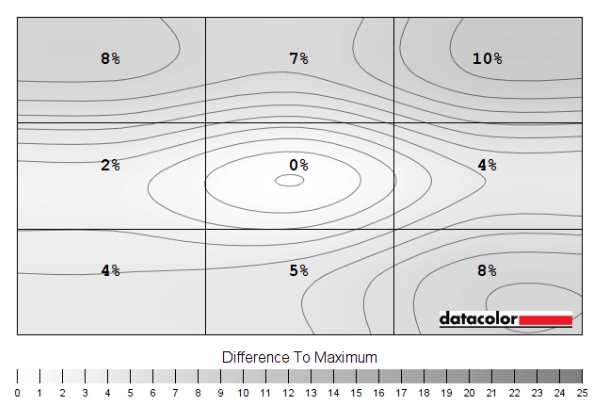
Luminance uniformity map
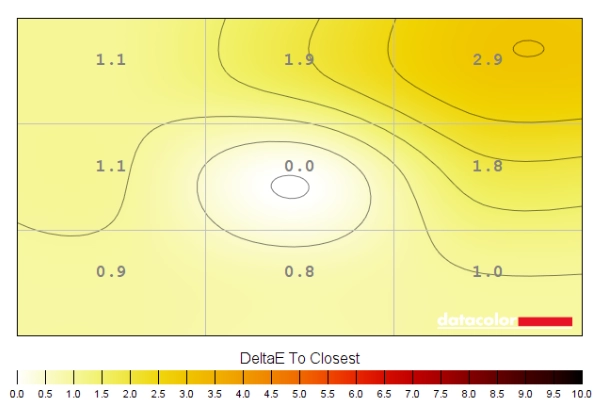
Colour temperature uniformity map
Contrast in games and movies
Lagom contrast tests
Colour reproduction
Colour gamut
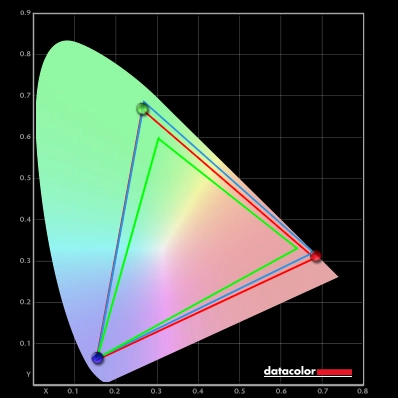
Colour gamut 'Test Settings'
The monitor also offers an sRGB emulation setting – the ‘sRGB’ setting in the ‘Picture’ section of the OSD. As noted earlier you can’t adjust the brightness and are restricted from making other adjustments, for example to colour channels or gamma mode. The gamut using this setting are shown below. Things track more closely to the sRGB colour space now, with the red triangle showing the measured gamut and the green triangle the sRGB reference space. There’s slight undercoverage (97%) but very little extension beyond. If you have a colour-managed workflow you’d get the highest levels of accuracy by full calibration and profiling with a colorimeter or similar device using the full native gamut. This sRGB emulation setting provides close tracking of the sRGB colour space where this is not possible, albeit with limited flexibility in the OSD. Alternatively, you may wish to try the ICC profile featured in the calibration section which includes gamut mapping for colour-aware applications whilst the monitor uses its native colour gamut. Best results are always obtained by calibrating your own unit with your own hardware, however.
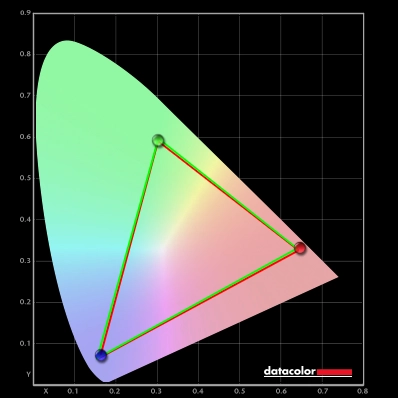
Colour gamut 'sRGB'
As an alternative to this sRGB emulation setting, AMD users can activate an sRGB emulation setting with superior sRGB coverage and flexibility. Simply use settings on the monitor which use the full native gamut, for example our ‘Test Settings’. Then open ‘AMD Radeon Software’, click ‘Settings’ (cog icon towards top right) and click ‘Display’. You should then ensure that the ‘Custom Color’ slider to the right is set to ‘Enabled’ and ‘Color Temperature Control’ set to ‘Disabled’. This is shown in the image below.

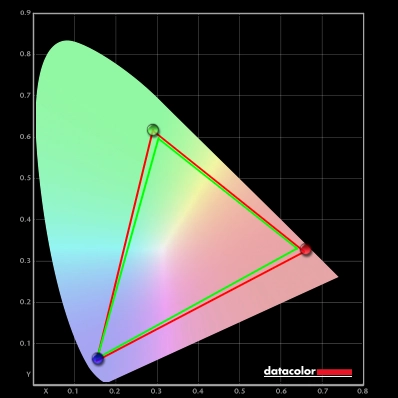
Colour gamut AMD 'CTC disabled' setting
Colour in games and movies
Viewing angles
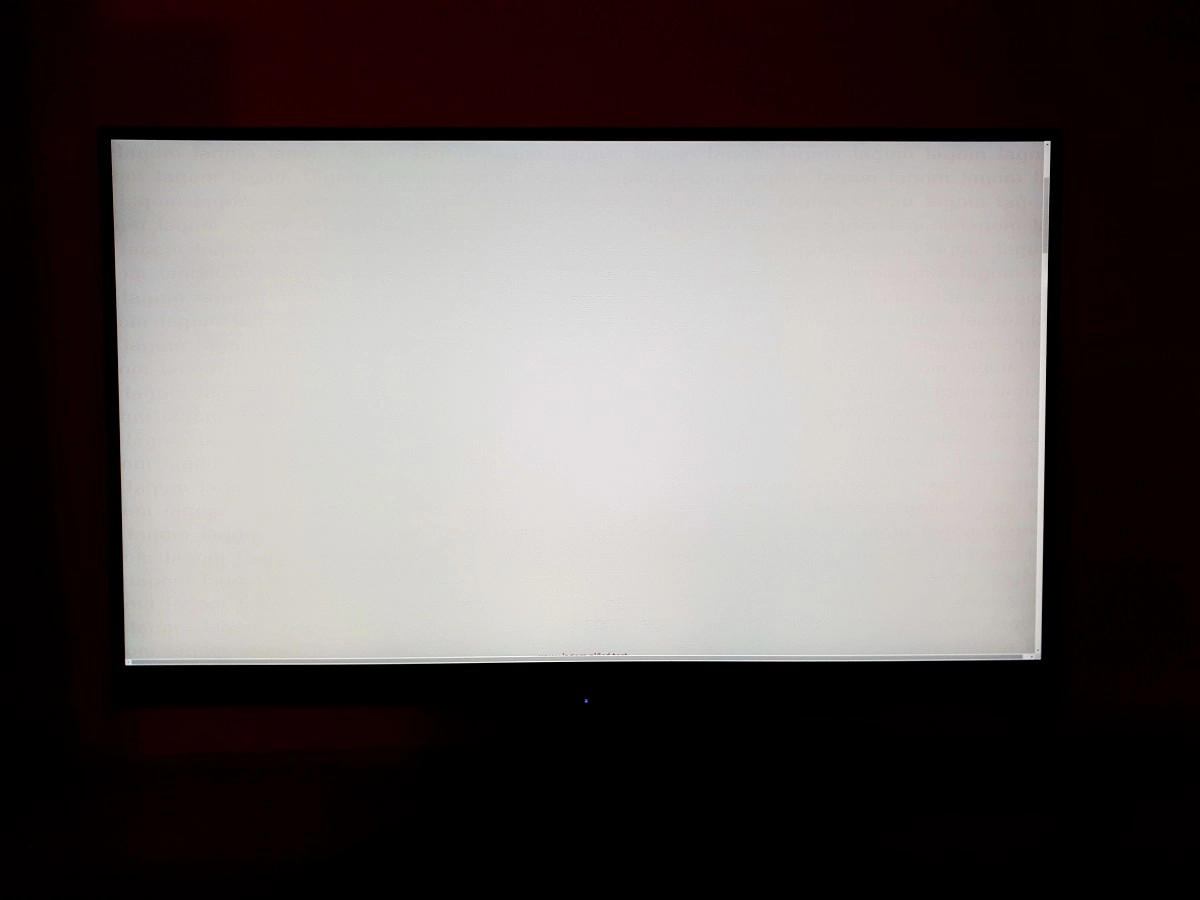
The video below shows the Lagom text test, a mixed desktop background and dark desktop background from a variety of viewing angles. You can see slight shifts in colour and contrast for the mixed desktop background, particularly from more acute viewing angles. But these shifts are less pronounced than on VA or TN models (and indeed some IPS-type models). The dark desktop background highlights ‘IPA glow’, specifically how it blooms out from sharper viewing angles with a strong golden (or slightly cool white, depending on angle) sheen.
Interlace pattern artifacts
Responsiveness
Input lag
Perceived blur (pursuit photography)
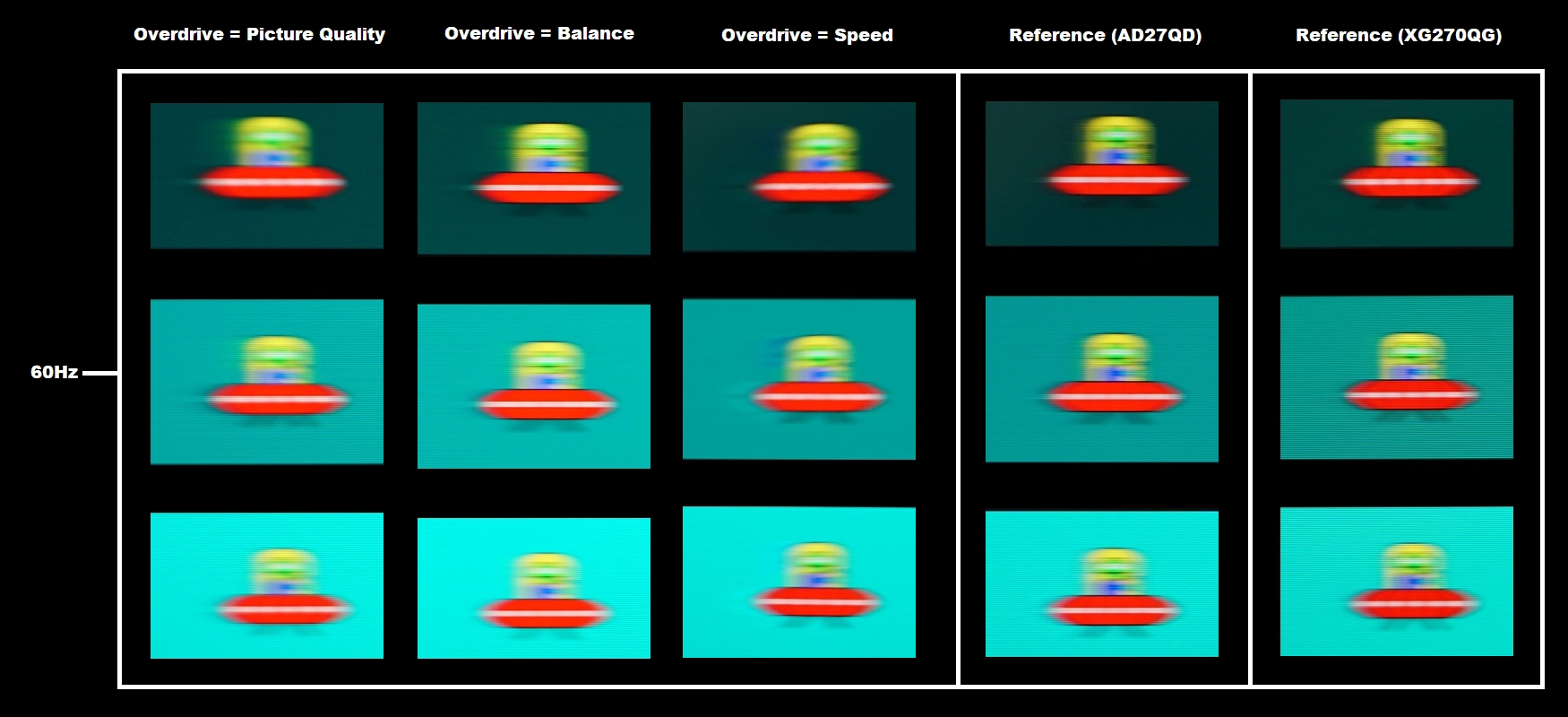
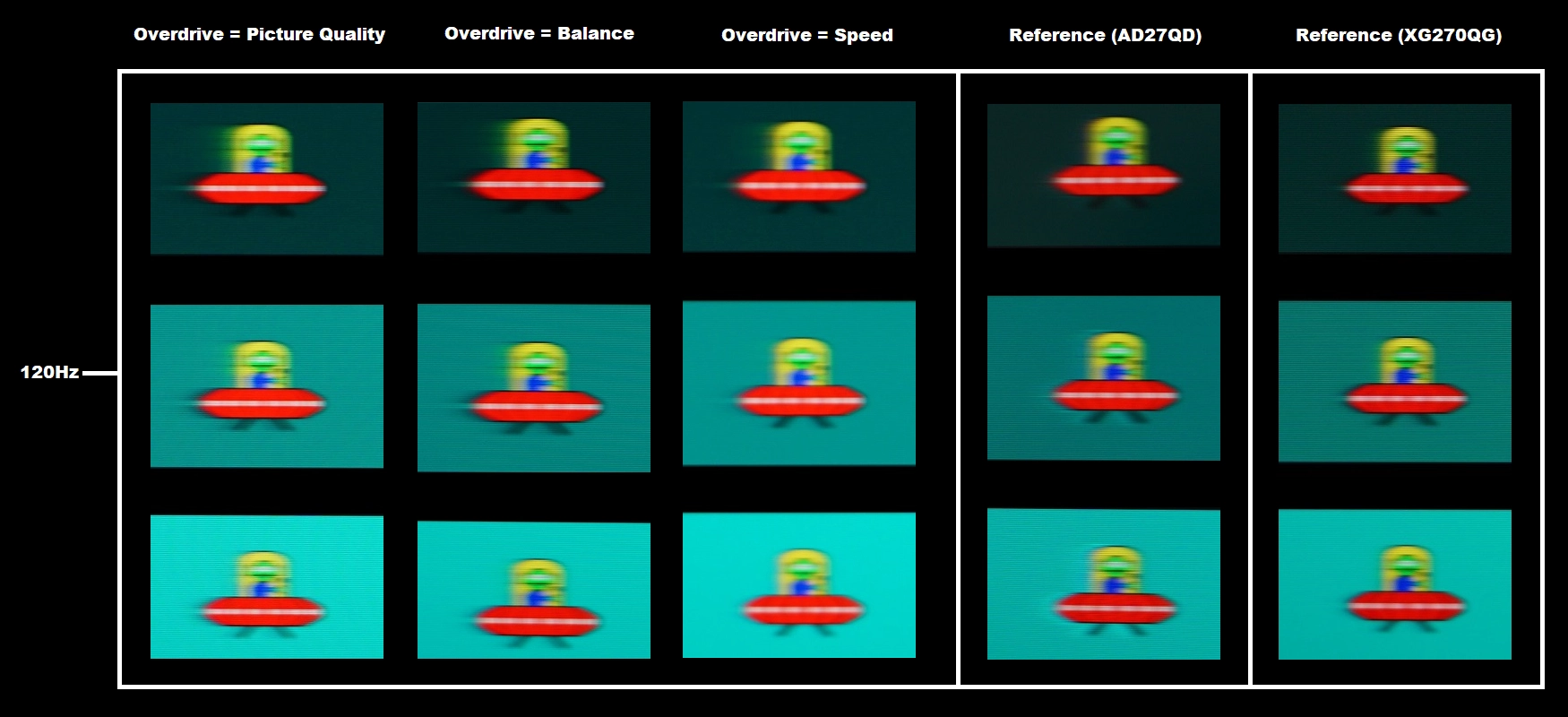
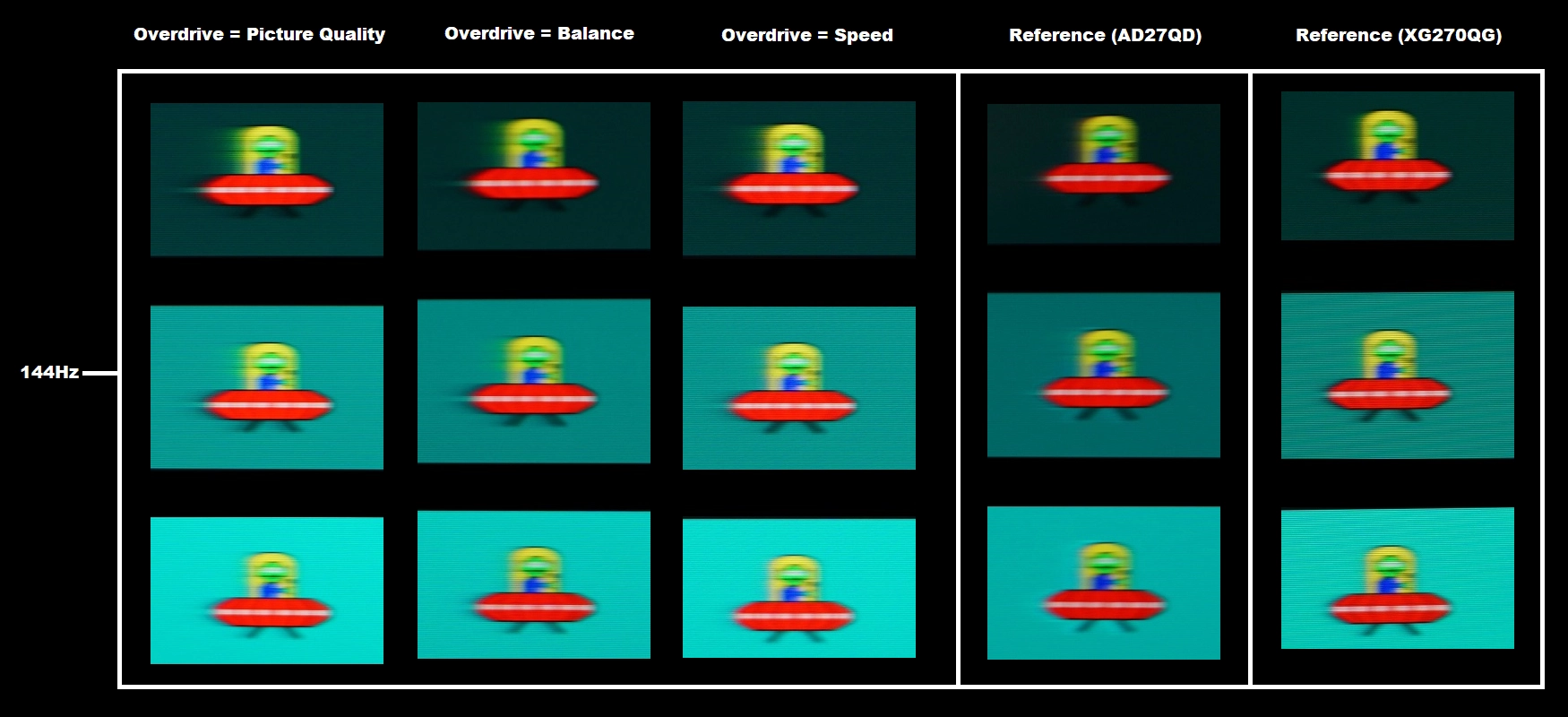
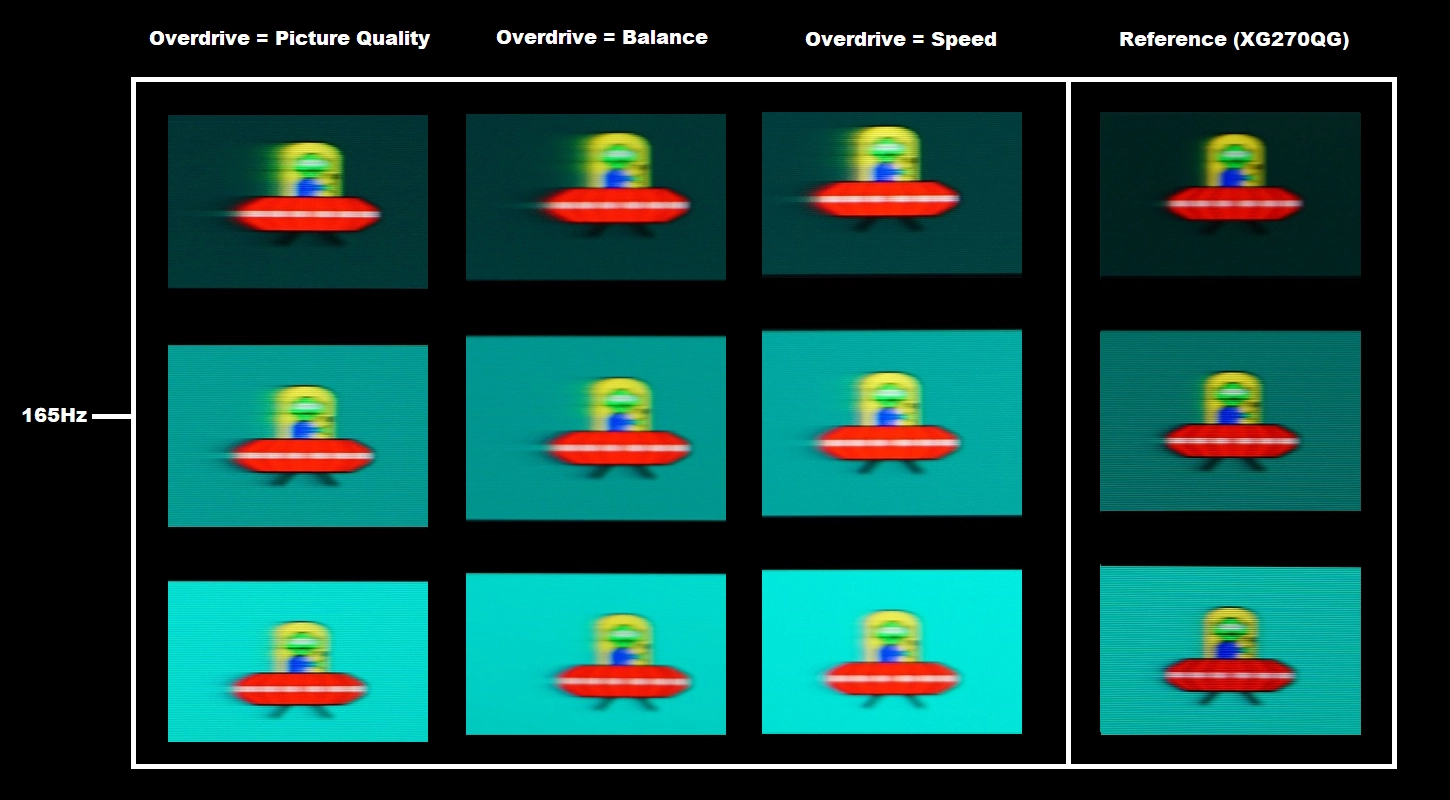
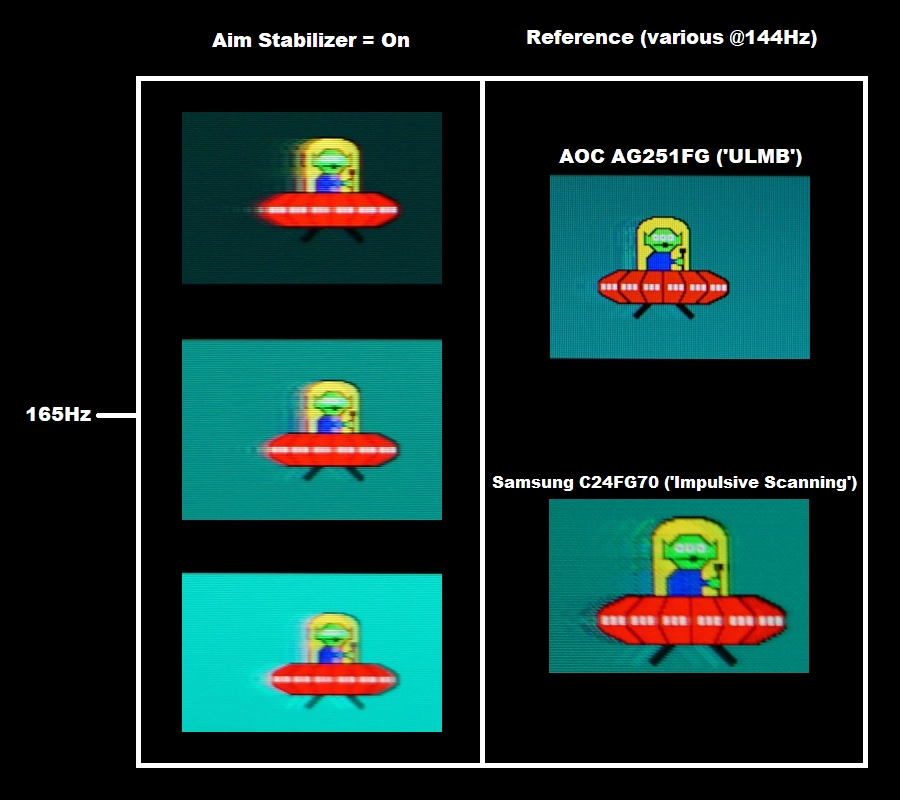

Responsiveness in games and movies
We had a similar experience on Shadow of the Tomb Raider, in terms of responsiveness. The excellent ‘connected feel’ was not so beneficial, competitively speaking, but was still nice to have and easy for us to notice and appreciate when playing the game. This title makes heavy use of those ‘high contrast’ transitions that this model performed a bit slowly in places. Again, it distanced itself from high contrast VA models as there wasn’t obvious ‘smeary’ trailing nor was there strong overshoot from the pixel overdrive trying hard to compensate for such weaknesses. The pixel overdrive was very well-balanced in our view and there was nothing that really distracted us from the gameplay. Normally (i.e. when not specifically testing high frame rate responsiveness), we’d use higher graphics settings and struggle to get 165fps or anywhere near on this title. That’s where Adaptive-Sync comes into play, as we explore shortly. This can introduce some more noticeable overshoot if using our preferred ‘Speed’ setting, but we still enjoyed the overall balance of image quality and responsiveness offered by the monitor on this title. We also observed movie and video content at various frame rates. This included ~24 – 30fps content on platforms such as Netflix as well as 60fps YouTube content. With such restricted frame rates the pixel response requirements are greatly reduced and you don’t put the 165Hz refresh rate to good use. We didn’t observe any obvious overshoot, perhaps slight traces in places but nothing eye-catching, and didn’t notice any clear weaknesses from slower than optimal pixel responses.

FreeSync – the technology and activating it
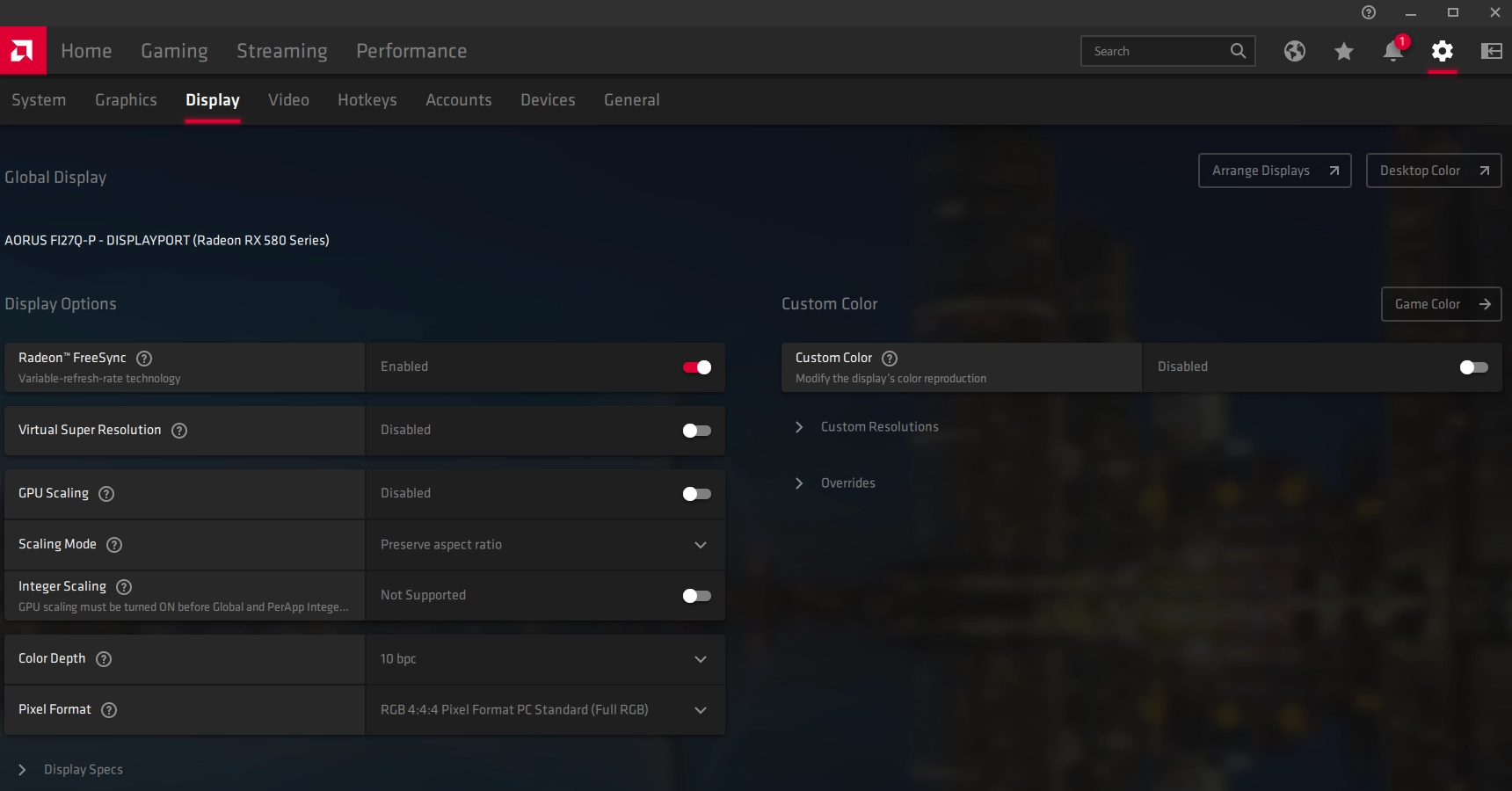
The Gigabyte AORUS supports a variable refresh rate range of 48 – 165Hz. That means that if the game is running between 48fps and 165fps, the monitor will adjust its refresh rate to match. When the frame rate rises above 165fps, the monitor will stay at 165Hz and the GPU will respect your selection of ‘VSync on’ or ‘VSync off’ in the graphics driver. With ‘VSync on’ the frame rate will not be allowed to rise above 165fps, at which point VSync activates and imposes the usual associated latency penalty. With ‘VSync off’ the frame rate is free to climb as high as the GPU will output (potentially >165fps). AMD LFC (Low Framerate Compensation) is also supported by this model, which means that the refresh rate will stick to multiples of the frame rate where it falls below the 48Hz (48fps) floor of operation for FreeSync. The variable refresh rate range and LFC support mean this model is AMD FreeSync Premium certified, specifically. If a game ran at 36fps, for example, the refresh rate would be 72Hz to help keep tearing and stuttering at bay. This feature is used regardless of VSync setting, so it’s only above the ceiling of operation where the VSync setting makes a difference.

Some users prefer to leave VSync enabled but use a frame rate limiter set a few frames below the maximum supported (e.g. 162fps) instead, avoiding any VSync latency penalty at frame rates near the ceiling of operation or tearing from frame rates rising above the refresh rate. If you activate the ‘Frame Counter’ in the ‘Game Setting’ section of the OSD, this will display the refresh rate of the display and therefore indicate the frame rate if ‘FreeSync’ is active and the frame rate is within the variable refresh rate range of the display. The refresh rate listed at the top of the ‘Gaming’ section of the OSD will also reflect the frame rate of the content when you first enter the OSD under these conditions. Finally, it’s worth noting that FreeSync only removes stuttering or juddering related to mismatches between frame rate and refresh rate. It can’t compensate for other interruptions to smooth game play, for example network latency or insufficient system memory. Some game engines will also show stuttering (or ‘hitching’) for various other reasons which won’t be eliminated by the technology.
FreeSync – the experience
Nvidia Adaptive-Sync (‘G-SYNC Compatible’)
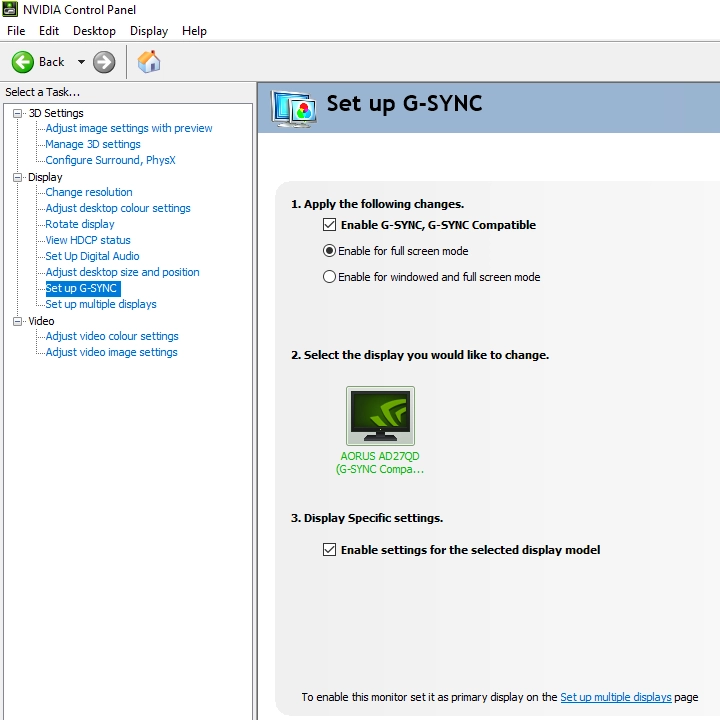
As noted previously and as highlighted in Nvidia Control Panel, this model has been specifically tested and validated as ‘G-SYNC Compatible’ by Nvidia. The experience using Nvidia Adaptive-Sync (G-Sync Compatible Mode) was overall very similar to the experience using AMD FreeSync on this model. This includes HDR being supported with Adaptive-Sync active. A slight difference was that the floor of the operation was 65Hz (65fps) rather than 48Hz (48fps) with 165Hz selected. The floor of operation was 60Hz (60fps) with 144Hz selected and 55Hz (55fps) with 120Hz selected. However; an LFC-like frame to refresh multiplication technology was employed below this to keep tearing and stuttering from mismatches between the two at bay. There was again a momentary stuttering as the boundary was crossed and having a somewhat higher floor of operation makes it more likely the boundary will be crossed. On the plus side, the floor being raised to 65Hz gets rid of any further overshoot increases as the frame rate falls below 65fps. Somewhat confusingly, you’d see less obvious overshoot at 64fps (128Hz) or below than at 65fps (65Hz) in your game.
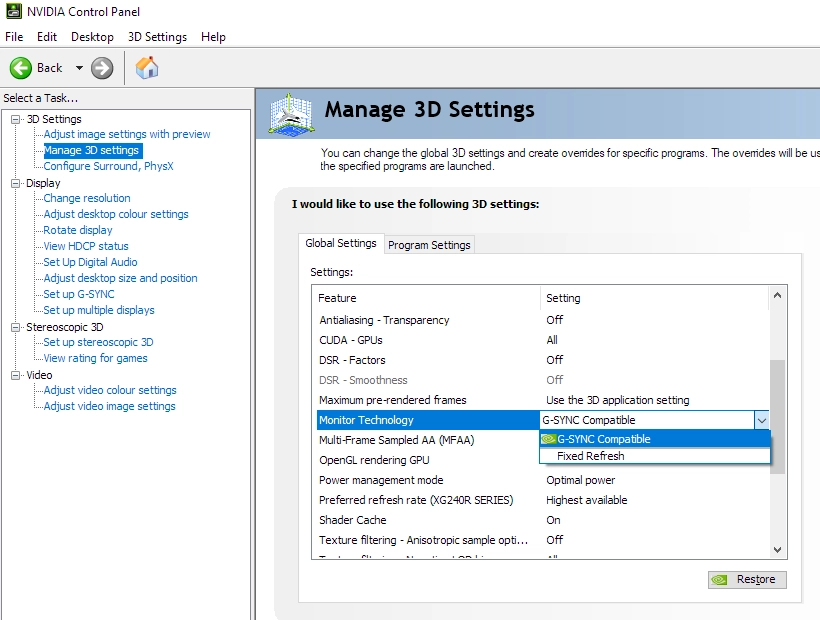
Finally, note again that you can activate the ‘Refresh Rate’ feature in ‘Game Assist’ to show the current refresh rate. This will adjust as the frame rate of the content changes and match the frame rate if it’s in the main variable refresh rate window (65 – 165fps). The refresh rate listed at the top of the ‘Gaming’ section of the OSD will also reflect the frame rate of the content when you first enter the OSD under these conditions.
Aim Stabilizer
HDR (High Dynamic Range)
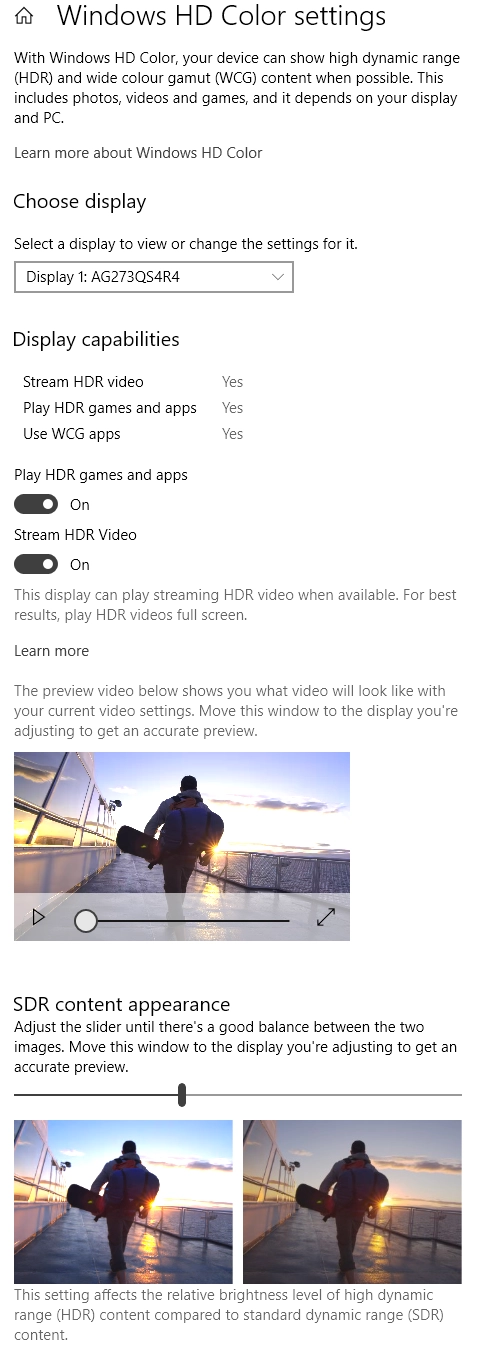

Colour gamut 'Test Settings'
The monitor supports 10-bits per channel colour output, as required for HDR10 content. Unlike many competing models, this doesn’t require a dithering stage to be offloaded to the GPU for its full native resolution and refresh rate. Instead, the monitor employs HBR3 (High Bit Rate 3) to enhance its bandwidth capabilities and enable 10-bit (8-bit + FRC) monitor-side alongside the full 2560 x 1440 resolution and 165Hz refresh rate. We did not notice any downside to this technology, it did exactly as it promised. But as we’ve also mentioned on many previous models that it’s important not to obsess over whether the GPU or monitor is handling this dithering stage over HDR. The end result is very similar, even if carefully observing content which includes fine gradients (smoke, weather effects, sky etc.) which could highlight some differences. Careful side by side comparison or observing certain content may reveal some subtle differences, though, and we understand that it’s reassuring for users to know the monitor is handling everything itself and not relying on the GPU to ‘fill in the gaps’.
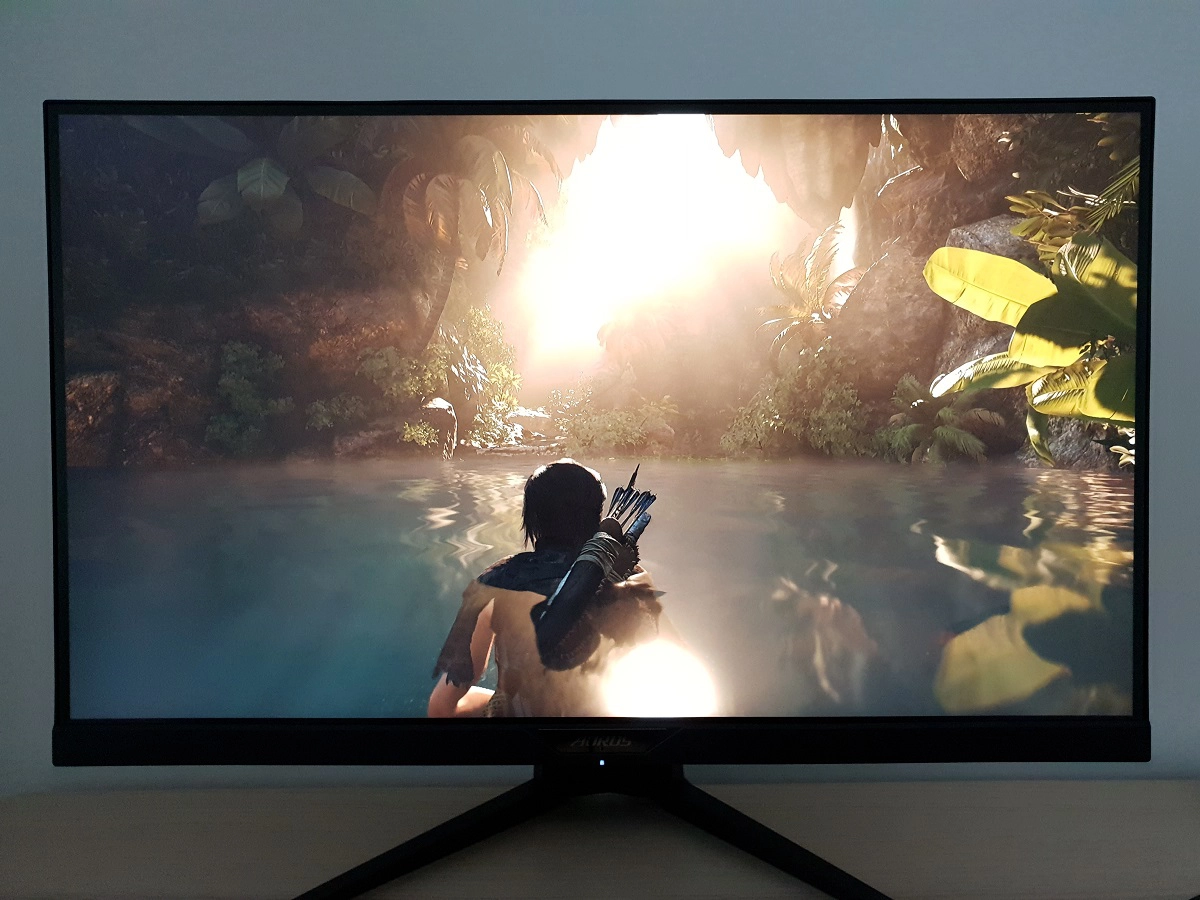
Interpolation and upscaling

Video review
Timestamps:
Features & Aesthetics
Contrast
Colour reproduction
HDR (High Dynamic Range)
Responsiveness
Conclusion
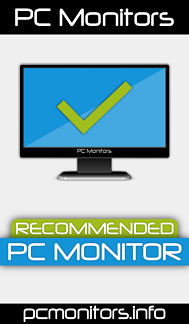
Positives Negatives Vibrant and varied colour reproduction, with strong consistency and generous extension beyond sRGB (95% DCI-P3) HDR performance brings some benefits and isn’t a bad VESA DisplayHDR 400 implementation, but it’s far from ‘full fat’ with no contrast or brightness advantage over SDR Respectable contrast performance, edging out some competitors and a decent screen surface helping avoid strong graininess to brighter content ‘IPS glow’ ate away at detail and atmosphere, but the effect was far from extreme on our sample Low input lag, a decent 165Hz performance with some rapid pixel responses and Adaptive-Sync doing its thing on both our Nvidia and AMD GPUs Some ‘powdery trailing’ in places and optimal pixel response time setting changes as refresh rate drops significantly (Adaptive-Sync without variable overdrive) A well-built product with good ergonomic flexibility, comprehensive OSD and software suite and a comfortable resolution and pixel density Stand is a bit of a desk depth hog and the RGB LED lighting feature offers little utility due to it being barely visible from the front
As an Amazon Associate I earn from qualifying purchases made using the below link. Where possible, you’ll be redirected to your nearest store. Further information on supporting our work.


![Switched on [overblown highlights due to camera]](http://pcmonitors.info/wp-content/uploads/2020/04/FI27Q-P-front-on.jpg.webp)
